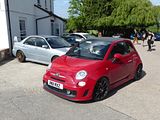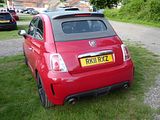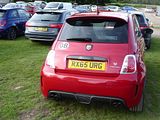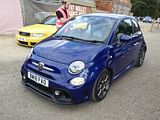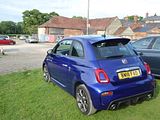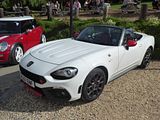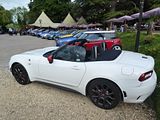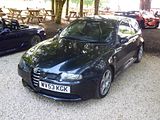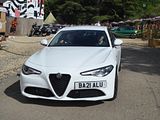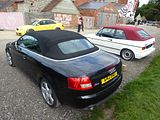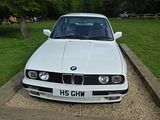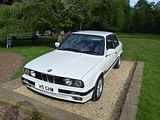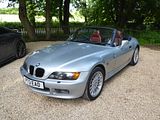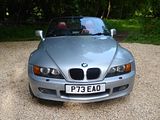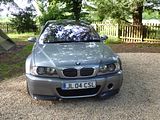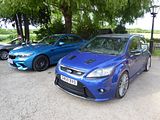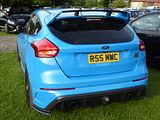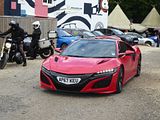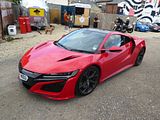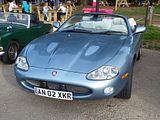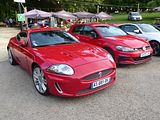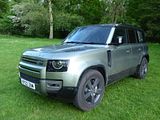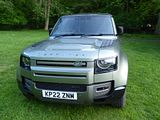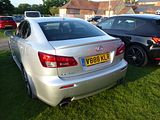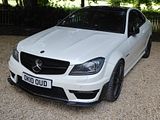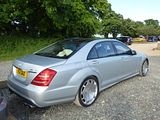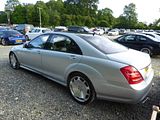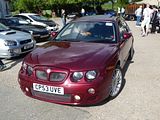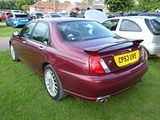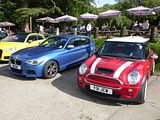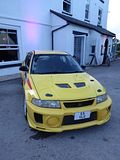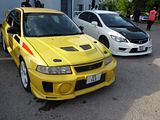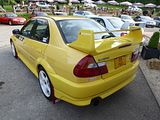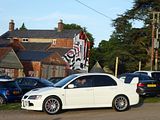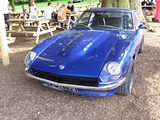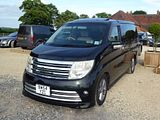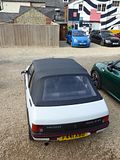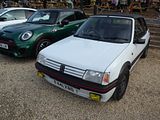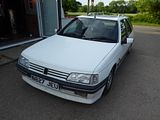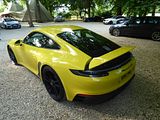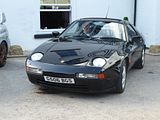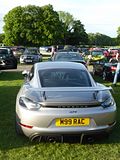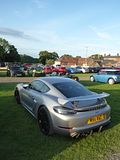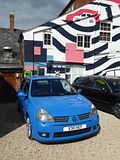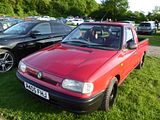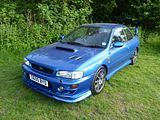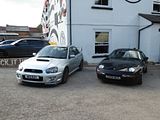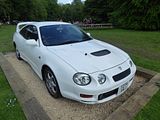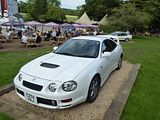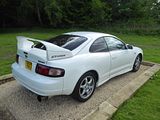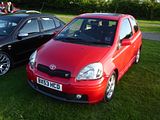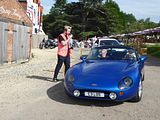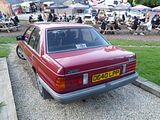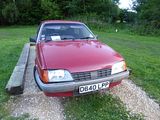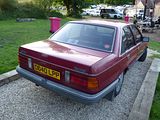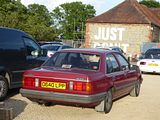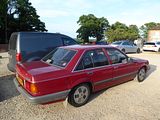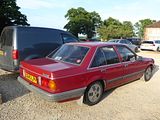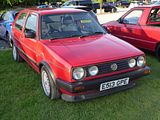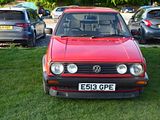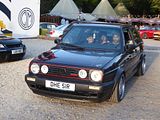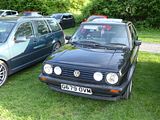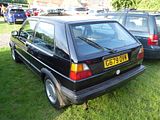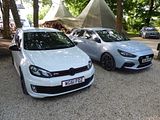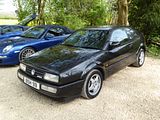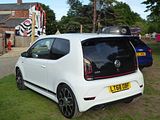Such is the enduring appeal of Caffeine & Machine that this is my fifth visit in 2022. The venue scores highly for accessibility being right in the middle of the country, and so when looking for a meeting place for a group of long-standing friends who live scattered around the UK, this is an obvious place to consider. Factor in the fact that you can be pretty sure of seeing an array of interesting cars parked up and that the food is generally pretty decent (though not exactly bargain priced) and you can see why so many people come here, me included. This visit was timed for the late afternoon/early evening slot, following a day spent at Prescott Hill Climb at their Clubs Day, for which a separate report has already been published. Some of the friends who had been at that venue also made the journey up to Ettington and I was able to catch up with others who had been able to make Prescott but who could get here. The sun was shining on arrival, and it stayed pleasant during my visit, and the site was already filling up with cars on this, the third of three bookable slots of the day. Presented here are the cars that caught my eye.
ABARTH
There usually a few Abarths here and that was the case on this occasion. Most of them were the 500-based models which have been on sale now since the end of 2008, following a launch at the Paris Show that year. Since that time there have been a number of detailed changes to the standard cars and a lot of limited editions. Those who really know the marque can spot most of them, but some are so subtle that unless there is a badge you can see, you will not be quite sure which version you are looking at. It used to be relatively easy, when the model was first launched, as there was only one version as shipped ex works called the 500. It had a 135 bhp 1.4 litre turbo-charged engine coupled to a five speed manual gearbox, with 16″ alloys as standard, and the option of 17″ wheels, and a colour palette comprising of two whites (BossaNova White, the standard colour, or the pearlescent Funk White), Red (Pasadoble), Pale Grey (Campovolo) or Black. If you wanted more power – 160 bhp – then you could order an Esseesse kit, which came in a large wooden crate, containing new wheels, springs, an ECU upgrade, the Monza exhaust system and badging. It was dealer fitted and could be applied at any time within the first 12 months or 10,000 miles from registration. Needless to say, it proved popular. As were many of the optional extras, with stickers for the sides, a large scorpion for the bonnet and even a chequered pattern for the roof among the personalisation options offered. Whilst a sliding glass sunroof (Skydome in Fiat/Abarth parlance) was an option from inception, fans of open air motoring had to wait until Geneva 2010 for the launch of the 500C models, with a roll-back roof which provided the best of open-topped motoring and yet still with the rigidity of the regular body style. For the first few months these cars only came with the robotised manual gearbox, which limited the appeal in the eyes of some, but they also introduced us to the “bi-colore”, a series of two tone cars, with upper and lower halves of the body painted in different colours. It took us a while to get used to this, as no other production road cars had been painted like this for some time, but now this is seen as yet another of those marque defining attributes, and (perhaps with the exception of the rarely seen Rally Beige and Officina Red combination that would come for 2014) in the eyes of many this distinctive look enhances the appeal of the cars still further.
Chronologically, in the now long model history of the 500-based cars comes mine. As is well documented here, this is one of the first of the 180 bhp Competizione cars, and is also referred to as a Series 3 model in the long running history of the 500/595 family of cars. Rumours started to circulate towards the end of 2014 that Abarth were going to upgrade the Competizione model, so as better to bridge the gap between the Turismo and the 190 bhp 695 Biposto that had been added to the range earlier in the year. It was Geneva 2015 when the result was finally shown to an expectant fan base. Most exciting news was that thanks to a bigger Garrett Turbo, the engine had been tweaked to 180 bhp, and with reduced CO2 emissions. A standard spec that included Koni Dampers, Brembo brakes, Xenon lights, Sabelt seats, Climate Control, parking sensors as well as other refinements that had been added like the TFT instrument display all proved very compelling, so not long after the first cars reached the UK in June of 2015, I found temptation too hard to resist, and as is well documented here, swapped my 2010 car for one of these. At the time I ordered it, Cordolo Red, a tri-coat pearlescent paint which shimmers in bright sunlight looked set to become one of the most popular colours of the lot, even though it is a cost option. Indeed, the Launch Edition models were all offered either in this colour or Scorpion Black, with black wheels. Surprisingly, the colour was not carried over to the Series 4 cars.
What is known as the Series 4 version of the familiar 595 reached the markets in the middle of 2016. After rumours had circulated all winter following the launch of the facelifted Fiat 500 last year, Abarth finally unveiled the Series 4 at the end of May 2016. Initially, we were told that the cars would not be available in the UK until September, but that came forward somewhat, with dealers all receiving demo cars in June, and the first customers taking delivery in July. Three regular production versions of both the closed car and the open-topped C were initially available, all badged 595, and called Custom, Turismo and Competizione, as before, though numerous limited edition models have since appeared and in most case disappeared. The most significant changes with the Series 4 are visual, with a couple of new colours, including the much asked for Modena Yellow and a different red, called Abarth Red, which replaces both the non-metallic Officina and – slightly surprisingly – the tri-coat pearlescent Cordolo Red. as well as styling changes front and rear. The jury is still out on these, with many, me included, remaining to be convinced. At the front, the new air intake does apparently allow around 15 – 20 % more air in and out, which will be welcome, as these cars do generate quite a lot of heat under the bonnet. Competizione models for the UK retain the old style headlights, as they have Xenon lights as standard, whereas the Custom and Turismo cars have reshaped units. At the back, there are new light clusters and a new rear bumper and diffuser. Inside, the most notable change is the replacement of the Blue & Me system with a more modern uConnect Audio set up, which brings a new colour screen to the dash. Mechanically, there is an additional 5 bhp on the Custom (now 145) and Turismo (now 165 bhp) and the option of a Limited Slip Diff for the Competizione, which is likely to prove a popular option. Details of the interior trim have changed, with a filled-in glovebox like the US market cars have always had, and electric windows switches that are like the US ones, as well as a part Alcantara trim to the steering wheel in Competizione cars. These cars have now been on offer for six years and with Abarth sales on the rise, it was no surprise that there was one here, in the popular Podium Blue colour.
Eagerly awaited, the 124 Spider went on sale in September 2016. A quick reminder as to what this car is: The Abarth 124 Spider was developed in parallel with the Fiat model. It does cost a lot more, and there are those who think you don’t get enough extra for your money, but those who have driven it will tell you otherwise. You certainly get more power. The 1.4 MultiAir turbo unit jumps up from 138bhp to 168bhp, while torque also increases by a modest 10Nm to 250Nm, which gives it a 0-62mph time of 6.8 seconds, which is half a second quicker than the 2.0-litre Mazda MX-5. The top speed is 143mph. It weighs just 1060kg meaning a power-to-weight ratio of 158bhp-per-tonne, and with the new Record Monza exhaust system it sounds great even at idle. The Abarth version gets a stiffer suspension setup than the regular Fiat 124 Spider, with Bilstein dampers and beefed-up anti-roll bars. Bigger Brembo brakes also feature, with aluminium calipers. It can be had with a six-speed manual or six-speed automatic transmission with paddles, and the latter gets a Sport mode for quicker shifts. Many of the UK cars sport the ‘Heritage Look’ pack, which is a no-cost option. It brings a matt black bonnet and bootlid, plus red exterior trim detailing and has proved popular. The £29,565 starting price gets you standard equipment such as cruise control, climate control, Bluetooth, a DAB radio and satnav, plus Alcantara black and red (or pure black) seat trim. The automatic gearbox is a £2,035 extra, while an optional visibility pack brings LED DRLs, auto lights and wipers and rear parking sensors
ALFA ROMEO
Having a rather short production life was the GTA version of the 147. Launched in 2002. this car was intended to compete with the most sporting Golf and Focus models of the day. as well as injecting more potency into a range which always seemed like it needed more power. Fitted with a 3.2 V6 engine which produced 247 bhp, the 147GTA was the most powerful hot hatch available at the time, and the modifications to the body, including lower sills and wider wheel arches, if anything, made it look even better rather than endowing it with the sort of “after market look” that can afflict some high end performance versions of regular family cars. Performance figures were impressive, with the car able to achieve a top speed of 153 mph. It had a widened body by 15 mm at each side to accommodate the 225/45R17 tyres. Most models had a 6-speed manual transmissions; whilst a smaller number of other models used the semi automatic Selespeed system. Production ran through to 2004 and in total 5,029 147 GTAs were built, 1004 of which were Selespeeds. Only around 300 came to the UK, so this was never a common sighting on British roads.
Also here was the well-received Giulia.
AUDI
This S4 Cabriolet belongs to my friend Bryan Macefield, one of a number of modern classics that he owns. He’s had this one for a couple of years but I’d never seen in in person before. As I had the saloon version of this car for three years, a while back, and of which I have very fond memories, I was particularly eager to reacquaint myself with the model. The third generation Audi S4 quattro (Type 8E — saloon: 8E2, Avant: 8E5, and Cabriolet: 8H7) debuted its saloon and Avant bodystyles in Europe in March 2003, and appeared in North America slightly later.This was based on the latest Volkswagen Group B6 (PL46) platform used by the then current Audi B6 A4. Despite having moved to an entirely new platform, one of the S4’s most publicised new features was its new engine – a 4.2-litre V8 engine. Following its initial launch of either a four-door five-seat saloon (sedan), or a five-door five-seat Avant (estate/wagon), it eventually became available in three bodystyles – and for the first time in the Audi ‘S’ car range, from February 2004, a two-door four-seat Cabriolet (convertible), Type 8H, was included in the model range. Official performance figures for standard discipline of sprinting from standstill to 100 km/h (62.1 mph) in the saloon with manual transmission are 5.6 seconds (Avant 5.8 s, Cabriolet 5.9 s), however, a road test conducted by the American automotive magazine Motor Trend indicated that it could go from a standstill to 60 mph (96.6 km/h) in less than 5 seconds, and make it to 200 km/h (124.3 mph) in slightly over 20 seconds, although doing this led to fuel consumption dipping into single digits. This was considerably worse than the earlier V6 models, leading to the addition of a $1,700 gas guzzler tax (combined 20.2 mpg US (11.6 L/100 km; 24.3 mpg‑imp)) for the six-speed manual sedan in the United States. Top speed is electronically limited to 250 km/h (155.3 mph). Replacing the 2.7-litre ‘biturbo’ V6 engine of the previous generation B5 S4, the new B6 S4 powertrain gained an all-aluminium alloy 4.2-litre, 40 valve (five valves per cylinder) V8 engine (parts code prefix: 079.C, identification code: BBK), with chain-driven double overhead camshafts, roller-finger rocker arm cam followers, and included variable inlet camshaft timing. It also used a strengthened alloy crankshaft bedplate for the five main bearings, and a two-part baffled oil sump, and a light-alloy variable intake manifold (VIM), containing the fractionally sequentially actuated fuel injectors. This petrol engine, based on the unit from the Audi A8, displaces 4,163 cc and it produces a motive power output of 344 PS (339 bhp) at 7,000 rpm, and generates torque of 410 Nm (302 lb/ft) at 3,500 rpm, making it more powerful than the RS2 Avant, and nearly as powerful as the B5 RS4. Engine management was by way of a Bosch Motronic ME 7.1.1 electronic engine control unit (ECU), using a Bosch ‘E-Gas’ drive by wire electronic throttle, and powering eight individual spark coils with longlife quad-electrode Bosch spark plugs. Ignition timing is a mapped direct ignition, with cylinder-selective knock control with the aid of four knock sensors. The exhaust system includes vacuum-operated valves in the twin rear silencers, finished with chrome plated tail-pipes. Like its predecessors, the B6 S4 was standard with a Getrag six-speed (M6S) manual transmission (parts code prefix: 0A3, identification codes: FVD, HEP) (gear ratios – 1st: 3.667, 2nd: 2.050, 3rd: 1.462, 4th: 1.133, 5th: 0.919, 6th: 0.778), with a 240 mm (9.4 in) single plate dry clutch, and Torsen T-2 quattro permanent four-wheel drive system. Final drive (parts code prefix: 01R, identification code: EXZ) ratios are 3.889, giving a top gear road speed to engine revs ratio of 24.4 mph (39.3 km/h) per 1000 rpm. From July 2003, the ZF 6HP19 tiptronic automatic transmission (parts code prefix: 09L, identification codes: GUR, HHU) (ratios – 1st: 4.171, 2nd: 2.340, 3rd: 1.521, 4th: 1.143, 5th: 0.867, 6th: 0.691, with a final drive (identification code: GDF) ratio of 3.539) was included as an option. An unusual sight in the engine compartment was the addition of water cooling for the 190 amp alternator, along with two additional thermostatically-controlled side-mounted radiators. The B6 S4 came equipped with electronically controlled, variable assisted ‘servotronic’ rack and pinion power assisted steering (PAS) as standard. B6 S4 brakes consisted of radially ventilated disc brakes front and rear. The front discs are sized at 345 mm (13.58 in) in diameter by 30 mm (1.181 in) thick, and are clamped by Continental Teves-ATE FNRG-60 single-piston sliding brake calipers. The rears are 300 mm (11.81 in) by 22 mm (0.866 in), and again use single-piston sliding calipers, with an integrated cable-operated hand brake mechanism. A Bosch ESP 5.7 Electronic Stability Programme system, complete with Anti-lock Braking System (ABS), Electronic Brakeforce Distribution (EBD), Emergency Brake Assist (EBA), Electronic Differential Lock (EDL) and Anti-Slip Regulation (ASR) – also known as traction control system, coupled with a dual-rate tandem vacuum servo provided the brake actuation. Standard wheels were ‘Avus-III’ die-cast aluminium alloy, 8.0Jx18H2 ET45 in size, and shod with 235/40 ZR18 95Y XL (eXtra Load) high performance tyres, with factory supplies being either Continental SportContact2 or Michelin PilotSport PS2. Discrete lower door trims, along with the now trademark Audi ‘S’ model vertical-emphasis line grille, and solid aluminium (later replaced with plastic covered by aluminium) exterior door mirrors, and S4 badging front and rear are all that visually distinguish the S4 from its related A4 brethren. In the interior, front and rear Recaro seats (fronts fully electric with the option of heated seats), as well as S4 logos in the instrument panel and door sills complete the detail. The B6 S4 saloon and Avant variants ceased factory production in December 2004, with the Cabriolet ending twelve months later at December 2005.
BMW
The BMW E30 is the second generation of BMW 3 Series, which was produced from 1982 to 1994 and replaced the E21 3 Series, and was the car which really saw the popularity of the 3 Series increase dramatically. Development of the E30 3 Series began in July 1976, with styling being developed under chief designer Claus Luthe with exterior styling led by Boyke Boyer. In 1978, the final design was approved, with design freeze (cubing process) being completed in 1979. BMW’s launch film for the E30 shows the design process including Computer-aided design (CAD), crash testing and wind-tunnel testing. The car was released at the end of November 1982. Externally, the E30’s appearance is very similar to twin headlight versions of its E21 predecessor, however there are various detail changes in styling to the E30. Major differences to the E21 include the interior and a revised suspension, the latter to reduce the oversteer for which the E21 was criticised. At launch, the car had a 2 door style like its predecessor and just four engines, all of them petrol: the 316 and 318 four cylinder units and the 320 and 323i 6 cylinders. This last was soon upgraded to a 2.5 litre unit. Diesel models were added during the 80s and there was an all-wheel drive 325iX option for continental European markets. In addition to the 2 door saloon and Baur convertible body styles of its E21 predecessors, the E30 became available by early 1984 as a four-door sedan and later a five-door station wagon (marketed as “Touring”). The Touring body style began life as a prototype built by BMW engineer Max Reisböck in his friend’s garage in 1984 and began production in 1987. The factory convertible version began production in 1985, with the Baur convertible conversions remaining available alongside it. Following the launch of the E36 3 Series in 1990, the E30 began to be phased out.
The BMW Z3 is a range of two-seater sports cars which was produced from 1995 to 2002. The body styles of the range are: 2-door roadster (E36/7 model code) and 2-door coupé (E36/8 model code). The Z3 was based on the E36 3 Series platform, while using the rear semi-trailing arm suspension design of the older E30 3 Series. It is the first mass-produced Z Series car. Development on the roadster began in 1991 and was led by Burkhard Göschel. The exterior was designed by Joji Nagashima, being completed in mid-1992 at 39 months before production and the design was frozen in 1993. Design patents were filed on April 2, 1994 in Germany and on September 27, 1994 in the US. The Z3 was introduced via video press release by BMW North America on June 12, 1995. Production began on September 20, 1995. Development on the coupé model was run by a group of BMW engineers outside of work in their own time. The Z3 Coupé shares the same platform and parts with the roadster, but features a chassis-stiffening hatch area and is 2.7 times stiffer in comparison. The Z3 Coupé was unveiled at the 1997 Frankfurt Motor Show. The Z3 was the first BMW model to be solely manufactured outside of Germany. It was manufactured in Greer, South Carolina. The 4-cylinder models feature a single tailpipe, while 6-cylinder models have dual tailpipes, wider rear fenders (for pre-facelift models) and a revised front bumper. M models featured the same wider fenders as the 6 cylinder models but with unique front and rear bumpers, side mirrors and the M division’s first use of a quad exhaust pipe arrangement. The 1.8, 2.0, and 2.2i models were unavailable in the United States, though the U.S. was the only market to receive the 2.3 and 2.5 models. M models were introduced in 1998 in roadster and coupé body styles and were powered by the S50, S52, or S54 straight-six engine depending on country and model year. The M models came with a 5-speed manual transmission. Production ended on June 28, 2002, with the Z3 line replaced by the E85 Z4.
The M3 version of the E46 3 Series was produced in coupé and convertible body styles. The E46 M3 is powered by the S54 straight-six engine and has a 0-100 km/h (62 mph) acceleration time of 5.1 seconds for the coupe, with either the manual or SMG-II transmission. The skid pad cornering results are 0.89 g for the coupe and 0.81 g for the convertible.The top speed is electronically limited to 250 km/h (155 mph). The available transmissions were a Getrag 420G 6-speed manual transmission or a SMG-II 6-speed automated manual transmission, which was based on the Getrag 420G.[58] The SMG-II used an electrohydraulically actuated clutch and gearshifts could be selected via the gear knob or paddles mounted on the steering wheel. The SMG-II was praised for its fast shift times and racetrack performance, but some people found its shifts to be delayed and lurching in stop-start traffic. In 2005, a special edition was introduced which used several parts from the CSL. This model was called the M3 Competition Package (ZCP) in the United States and mainland Europe, and the M3 CS in the United Kingdom. Compared to the regular M3, the Competition Package includes: 19-inch BBS alloy wheels- 19″x 8″ at the front and 19″x 9.5″ at the rear; Stiffer springs (which were carried over to the regular M3 from 12/04); Faster ratio steering rack of 14.5:1 (compared with the regular M3’s ratio of 15.4:1) as per the CSL; Steering wheel from the CSL; M-track mode for the electronic stability control, as per the CSL; The CSL’s larger front brake discs (but with the regular M3 front calipers) and rear brake calipers with larger pistons; Alcantara steering wheel and handbrake covers; The engine, gearbox and other drivetrain components are the same as the standard M3. Total production of the E46 M3 was 56,133 coupes and 29,633 convertibles. The cars were assembled at the BMW Regensburg factory in Germany and production was from September 2000 until August 2006, production totalled 85,766.
FORD
Most recently, the most sporting Fords have been the RS versions of the Focus. On each occasion there was been a long wait for the car after the launch of the cooking models. The regular second generation cars were released in late 2004. An ST version followed very quickly, and for a long time, Ford maintained that was the only sporty Focus there was going to be. Finally, on December 17, 2007 Ford of Europe confirmed that a Mk 2 Focus RS would be launched in 2009, with a concept version due in mid-2008. t with an upgraded Duratec ST engine with 305PS Duratec RS, gearbox, suspension, and LSD. In 2008, Ford revealed the new Focus RS in “concept” form at the British International Motor Show. Contrary to numerous rumours and speculation, the RS was announced by Ford to have a conventional FWD layout. The Duratec RS engine was upgraded to produce 301 bhp and 325 lb/ft of torque. 0 to 100 km/h (62 mph) acceleration was quoted to be under 6 seconds. The RS used a modified Volvo -engineered 2,522cc five-cylinder engine found in the Focus ST. A larger Borg Warner K16 turbo now delivers up to 20.3-psi of boost. A new air-to-air intercooler has been developed as a complement, while the forged crankshaft, silicon-aluminum pistons, graphite-coated cylinder bores, 8.5:1 compression ratio and variable valve timing also up the power output. The car remained front wheel drive, but to reduce torque steer used a Quaife Automatic Torque Biasing LSD, and a specially designed MacPherson strut suspension at the front called RevoKnuckle, which provided a lower scrub radius and kingpin offset than traditional designs while avoiding the increased weight and complexity of double wishbone and multi-link suspension setups. Ford UK claim: “It’s as close as you’ll come to driving a full-spec rally car (Ford Focus RS WRC). The production car was finally unveiled on 5 January 2009. It looked very distinctive, as at the rear a large venturi tunnel and a dramatic rear spoiler created a purposeful look. It was available in three expressive exterior colours: Ultimate Green, Performance Blue and Frozen White. The ‘Ultimate’ Green was a modern reinterpretation of the classic 1970s Ford Le Mans Green of the Ford Escort RS1600 era.
Ford played much the same guessing game about whether there would be an RS version of the third generation car as they had done with the earlier versions. Production of the regular cars started in late 2010, but it was not until the 2015 Geneva Motor Show before the production ready MKIII Ford Focus RS was unveiled. It came packing the turbocharged 2.3-litre inline-four engine found in the Mustang EcoBoost. In the Focus RS, the engine itself produces 350 hp. Power is sent to all four wheels via Ford’s all-new Torque-Vectoring All-Wheel-Drive system with a rear drive unit designed by GKN, as well as upgraded suspension and brakes. As well as that, the new Focus RS will be fitted with Drive Modes – including an industry-first Drift Mode that allows controlled oversteer drifts – and Launch Control. The RS will boast a model specific aerodynamic package that helps to differentiate it from other Focus models. The RS is capable of accelerating to 100 km/h (62 mph) in 4.7 seconds. Sales finally started in mid 2016, with long waiting lists having been created, though Ford did eventually catch up with expanded production levels allowing them to meet the demand.
HONDA
The third generation of the Civic Type R was offered in two distinct models: one developed for the Japanese domestic market and the other for UK and international markets each matching the availability of their regular 8th generation counterparts. The Japanese market Civic Type R (FD2) went on sale on 30 March 2007. For the first time, the JDM Civic Type R was sold as a four-door sedan, rather than a three-door hatchback. The FD2 Type R was bigger, wider and heavier than the EP3 Type R. The wheelbase grew from 2,570 mm (101.2 in) to 2,700 mm (106.3 in), giving the FD2 more stability during high speed cornering. The Japanese model’s engine power output is higher than the European versions, with 225 PS (222 bhp) being generated at 8,000 rpm and 215 Nm (159 lb/ft) of torque peaking at 6,100 rpm (versus 201 PS (198 bhp) at 7,800 rpm and 193 Nm (142 lb/ft) at 5,600 rpm for the European model). Honda quoted that mid-range is increased by 10 PS (10 bhp). Power is sent to the front wheels through a close-ratio six-speed manual transmission, and a helical limited slip differential is fitted as standard. The front brake discs are 320 mm (12.6 in) diameter and fitted with four piston Brembo calipers. The car is fitted with Bridgestone Potenza RE070 tires having a size of 225/40 R18. Honda claims the chassis is 50% more rigid than the previous Japan-only pre-facelift DC5 Integra Type R and 25% more rigid than the previous Japan-only facelift DC5 Integra Type R. The FD2 features an independent rear suspension rather than the torsion beam configuration used on the FN2 Type-R. To save weight, aluminium is used extensively and bonded with adhesive instead of welded. Though the chassis is larger and more rigid than the JDM Integra Type R, it is only 70 kg (154 lb) heavier. Exterior wise, the front bumper is wider and different from the standard Civic designed aerodynamically. The rear bumper features a diffuser built into the bumper and a large rear wing completes the aero package. Inside, the trademark black and red bucket seats are no longer made by Recaro as with previous versions but designed in-house by Honda. Also gone is the Momo made steering wheel, instead replaced by a Honda made version. The familiar red-on-black colour scheme or black-on-black scheme is offered on Championship White and Super Platinum Metallic Silver while a black-on-black scheme with red stitching is for the Vivid Blue Pearl model only. In October 2008, the Type R received new colors, those being Premium White Pearl, Premium Deep Violet Pearl and Crystal Black Pearl. The Vivid Blue Pearl colour was dropped. In back to back tests, the Civic Type R (FD2) was on average 1 second quicker than the Integra Type-R (DC5) at the Tsukuba Circuit and four seconds faster at the longer Suzuka Circuit. In a back-to-back test on the United Kingdom TV program Fifth Gear, the FD2 Type-R was three seconds quicker than the equivalent FN2 UK version around Castle Combe Circuit in wet conditions. However, the FN2 managed a 13.1 second quarter mile pass at Killarney Raceway. Approximately 13,000 units of FD2 Civic Type R were produced until it ceased production in August 2010 due to failure to meet the upcoming emission requirements. Following the previous success due to the introduction of the FN2 Civic Type R from Europe in 2009, another batch of FN2 Type R with minor updates was available in Japan from fall 2010. However, the engine was the same K20ZA straight-4 as used in the European version. In addition to Civic Type R, 300 units of Honda Civic Mugen RR cars available exclusively in Milano Red had also been produced for Japanese market, which reduced weight to 1,255 kg (2,767 lb) using carbon fibre bumpers and aluminium for the hood. The engine is rated at 240 PS (237 bhp) at 8,000 rpm and 218 Nm (161 lb/ft) torque at 7,000 rpm achieved through Mugen parts such as camshafts, exhaust system and ECU. Other exclusive items include Recaro SP-X racing bucket seats and other Mugen items on the interior while special 18 inch Mugen 7-spoke wheels come equipped as standard. It went on sale in Japan on 13 September 2007. Mugen also debuted the Civic Type-RR Experimental Spec concept car at the 2008 Tokyo Auto Salon, which featured a 2,157 cc K20A engine rated at 260 PS (256 bhp) at 8250 rpm and torque of 237 Nm (175 lb/ft) at 6,750 rpm. Weight is further reduced using an aluminium hood (4.6 kg (10 lb)), as well as a new titanium exhaust system (7.6 kg (17 lb)). The interior was also updated with more carbon fiber parts. The car also features Intelligent-Tire Condition Monitoring System (i-TCMS) and Recaro seats. The Honda Civic Mugen RR Advanced Concept was debuted at the 2009 Tokyo Auto Salon, based on the face-lifted FD2. It has a dry weight of 1,095 kg (2,414 lb). Brake disc size was increased to 340 mm (13.4 in) diameter (as compared to 320 mm (12.6 in) in Type R/RR). A race version called Honda Civic Mugen RC was developed by Mugen for the 2008 Honda Exciting Cup Civic One-Make Race-Civic Series. The engine is the stock K20A engine from FD2 Honda Civic Type R. It adds a racing wheel package (Mugen RC 18-inch wheel with Yokohama tyre), brake package (front and rear brake pads), seat and steering (Recaro bucket seat, seat rail, steering wheel with box, TAKATA harness), carbon inner part option A (carbon fiber right floor cover panel, footrest, door lining). It adds carbon inner part option B (carbon-fibre console box, left floor cover panel, centre pillar cover), engine package (engine rebalancing and calibration). The Civic Mugen RC was built in Mugen’s M-TEC factory.
In December 2007, Acura announced plans to launch a NSX successor by 2010, based on the styling of the front V10-engined Acura ASCC (Advanced Sports Car Concept). Despite prototypes being tested for production, just a year later, Honda announced that plans had been cancelled due to poor economic conditions. Instead, in March 2010, Honda unveiled the HSV-010 GT for participation in the Japanese SuperGT Championship. This car never reached production as a street-legal car. Reports that Honda was again developing a successor to the NSX remerged in April 2011. By December 2011, Honda officially announced a second generation NSX concept, which was unveiled the following month at the 2012 North American International Auto Show as the Acura NSX Concept. The production model was displayed three years later at the 2015 North American International Auto Show, for sale in 2016. Although the original name was retained, this time it was defined as “New Sports eXperience”. Unlike the first generation NSX which was manufactured in Japan, the new NSX was designed and engineered in Marysville, Ohio, at Honda’s plant, led by chief engineer Ted Klaus. The new NSX has a hybrid electric powertrain, with a 3.5 L twin-turbocharged V6 engine and three electric motors, two of which form part of the “SH-AWD” all wheel drive drivetrain, altogether capable of close to 600 hp. The transmission is a 9-speed dual-clutch automatic. Its body utilizes a space frame design—which is made from aluminium, ultra-high-strength steel, and other rigid and lightweight materials, some of which are the world’s first applications. The first production vehicle with VIN #001 was auctioned off by Barrett Jackson on 29 January 2016. NASCAR team owner Rick Hendrick won the auction with a bid for US$1,200,000. The entire bid was donated to the charities Pediatric Brain Tumor Foundation and Camp Southern Ground. The first NSX rolled off the line in Ohio on 27 May 2016. Hendrick was there to drive it off. The first sales of the new NSX were registered in the second half of 2016
HYUNDAI
One of the popular cars frequently seen at this venue is Hyundai’s first and highly rated hot hatch, the i30N.
JAGUAR
Few would have guessed that the XJS would run for over 20 years, but eventually it came time for its replacement, and the car charged with so doing was the XK8. Development began in 1992, with design work having starting earlier, in late 1991. By October 1992 a design was chosen and later frozen for production in 1993. Prototypes were built from December 1993 after the X100 was given formal approval and design patents were filed in June 1994. Development concluded in 1996, at which point the car was launched. The first-generation XK series shares its platform with the Aston Martin DB7, and both cars are derived from the Jaguar XJS, though the platform has been extensively changed. One of the revisions is the use of the second generation of Jaguar’s independent rear suspension unit, taken from the XJ40. The XK8 was available in coupé or convertible body styles and with the then new 4.0-litre Jaguar AJ-V8 engine. In 1998 the XKR was introduced with a supercharged version of the engine. 2003 the engines were replaced by the 4.2-litre AJ34 engines in both the normally aspirated and supercharged versions. Equipment levels were generous and there was a high standard of fit and finish. Both models came with all-leather interior, burl walnut trim, and side airbags. Jeremy Clarkson, during a Top Gear test-drive, likened the interior of the original XK8 to sitting inside Blenheim Palace. The model ran for 10 years before being replaced by the X150 model XK.
The second generation of the XK debuted in 2005 at the Frankfurt Motor Show in Germany, styled by Jaguar’s chief designer Ian Callum. The X150’s grille was designed to recall the 1961 E-Type. The XK is an evolution of the Advanced Lightweight Coupé (ALC) introduced at the 2005 North American International Auto Show. The XK features a bonded and riveted aluminium chassis shared with the XJ and body panels, both a first for a Jaguar grand tourer. Compared to the XK (X100), the XK (X150) is 61.0 mm (2.4 in) wider and is 162.6 mm (6.4 in) longer. It is also 91 kg (200 lb) lighter resulting in performance and fuel consumption improvements. Unlike the X100, the X150 has no wood trim on the interior offered as standard equipment. The interior featured steering column mounted shift paddles. A more powerful XKR version having a supercharged variant of the engine was introduced in 2007. The XK received a facelift in 2009,[10] with minor alterations to front and rear lights and bumper designs, together with the introduction of a new 5.0-litre V8 for both the naturally aspirated XK and the supercharged XKR. The interior also received some changes, in particular the introduction of the XF style rotary gear selector mated to the new ZF automatic transmission. The XK received a second and more minor facelift in 2011 with new front bumper and light design, which was presented at the New York Auto Show. A higher performance variant of the XKR, the XKR-S, was introduced at the Geneva Motor Show in 2012. The XKR-S gained an additional 40 bhp over the XKR bringing the 0-60 mph acceleration time down to 4.4 seconds and the top speed up to 300 km/h (186 mph). A convertible version of the XKR-S was introduced in 2012. Production of the XK ended in July 2014 without a replacement model.
LAND ROVER
This new Defender 110 is the recently acquired company car of my friend Piers Roache. He works for JLR and was quite surprised to be offered it, as he had originally ordered a Discovery, and with Defender sales running so high, with the factory unable to produce cars quickly enough, he was not expecting that the order could be switched. But it was, and needless to say, he loves it.
LEXUS
The IS-F is quite a rarity. Following lots of rumours, at the North American International Auto Show on 8 January 2007, the new IS F sedan was debuted to the public along with the LF-A supercar concept. Images were leaked a couple of hours before the official announcement. At its press debut, Lexus revealed that a separate “skunk works” team designed the IS F in a manner distinct from typical Lexus engineering efforts. The chief engineer of the IS F, Yukihiko Yaguchi, previously worked on the Toyota Supra. Much of the IS F’s suspension tuning took place at Fuji Speedway in Japan. The IS F vehicle body was lowered by 1 cm (0.5 inches) compared to the standard IS.[45] The hood features a bulged appearance, with sharper curve than the standard IS, due to the added space needed to contain the 5.0 L V8 engine. The drag coefficient is 0.30 Cd. The exterior also features a wire-mesh grille, changed side fenders and skirts, along with side air vents. One noticeable element of the IS F design were its faux quad exhaust tailpipes consisting of two vertically stacked exhaust tips on each side that did not directly connect to the actual exhaust pipes ( tips were part of the bumper, rather than the exhaust). The interior features a four-passenger cabin with braided aluminium panels, steering wheel paddle shifters, and F marque emblems. The IS F also features different seating, with bucket seats in front and rear. The Lexus IS F features a 4,969 cc direct-injected 2UR-GSE V8 producing 416 bhp at 6600 rpm, while peak torque is 371 lb/ft (503 N⋅) at 5200 rpm. The engine redlines at 6800 rpm and also features a two-stage intake system, engine oil and automatic transmission fluid coolers and an oil pump designed for high-speed cornering. Along with both port and direct injection, the engine features VVT-iE camshaft timing, and has a compression ratio of 11.8:1. The 2UR-GSE is derived from the Lexus UR-series V8 engines, which debuted as the 1UR-FSE on the 2007 Lexus LS 460. Of the UR-series V8s, the 2UR-GSE is most closely related to the 2UR-FSE used in the 2008 LS 600h. It features the same bore and stroke dimensions (3.70 in x 3.52). However, extensive modifications carried out by the IS F engineering team in conjunction with Yamaha’s Formula One (F1) engine program resulted in a cast-aluminium intake manifold, new cylinder heads, and titanium intake valves. Additionally the engine features a forged crankshaft, connecting rods and cam lobes. At maximum acceleration above 3400 rpm, the secondary intake opens. Compared with the LS 600h’s 2UR-FSE (measured alone without its hybrid-electric motors), the IS F 2UR-GSE has more horsepower and torque at higher rpm, and 17 lb·ft less peak torque. The car was received reasonable reviews, but sales in the UK and Europe were negligible.
McLAREN
In June 2018, McLaren unveiled the top-of-the-line sports series variant online. The car, called the 600LT is based on the 570S and is the third McLaren production car to receive the longtail treatment. Inspired by the 675LT and the F1 GTR Longtail, the body of the car has been extended by 73.7 mm (2.9 in). The car also features enhanced aerodynamic elements such as an extended front splitter and rear diffuser, new side sills, and an aero-enhancing fixed rear wing for increased downforce. McLaren claims that 23% parts on the 600LT are new as compared to the 570S. The carbon fibre monocoque utilised in the 600LT is modified and this combined with the extensive use of carbon fibre in the roof along with the cantrails and front wings, results in a weight saving of 96 kg (212 lb) over the 570S, with the total weight amounting to 1,247 kg (2,749 lb). Another distinguishing feature of the 600LT is the lightweight titanium exhaust system which is mounted on top of the rear of the car which harks back to its original application in the Senna. The interior features sports bucket seats from the P1 and Alcantara trim but can be optioned with the much lighter bucket seats found in the Senna. The 3.8-litre twin-turbocharged V8 engine utilised in the 600LT is tuned to produce a maximum power output of 600 PS (592 bhp) (hence the 600 in the name) and 620 N⋅m (457 lb⋅ft) of torque, achieving a power-to-weight ratio of 479 PS per tonne. Performance figures and production numbers of the car remain unknown. Production of the 600LT started in October 2018. In January 2019, McLaren unveiled the convertible variant of the 600LT at the Detroit Auto Show. Due to the use of the same carbon monocoque as the other models in the 570S lineage the 600LT Spider required did not need any extra modifications to incorporate a folding hardtop roof. As a result, the Spider weighs 50 kg (110 lb) more than the coupé while maintaining the same performance statistics. The Spider has the same engine and aerodynamic components as the coupé and share the roof folding mechanism with the standard 570S Spider which can be operated at speeds upto 40 km/h (25 mph). The car can accelerate to 100 km/h (62 mph) in 2.9 seconds, to 200 km/h (124 mph) in 8.4 seconds (0.2 seconds more than the coupé) and can attain a top speed of 315 km/h (196 mph) with the roof retracted and 323 km/h (201 mph) with the roof closed. The car can achieve a dry weight of 1,297 kg (2,859 lb) when equipped with the MSO ClubSport package which includes the removal of air-conditioning and radio, titanium wheel nuts and the replacement of the standard seats with the carbon fibre seats from the Senna. The car has received rave reviews.
MERCEDES-BENZ
Part of the W204 generation of C Class models, this is a C63 AMG Coupe. The C 63 AMG is reportedly the first AMG-Mercedes designed from the ground up. Its AMG C-Class predecessors had essentially featured bolt on performance modifications, and according to Car and Driver, these earlier AMG models suffered from “relentless understeer” and “heavy steering”. The C 63 AMG has a revised front suspension that is shared with the CLK 63 AMG Black Series. The ESP features a full defeat mode, interfering only under heavy braking. The C 63 AMG also has the quickest, most responsive steering of any Mercedes automobile to date. The Mercedes-Benz M156 engine, despite being detuned compared to other AMG offerings using the same powerplant, still provides the C 63 AMG with more horsepower and torque over its direct rivals such as the Audi RS4 and BMW M3. The 7G-Tronic 7-speed automatic transmission has AMG SpeedShift with four shift modes – Comfort, Sport, Sport + and Manual – with the last one running with the converter locked allowing the driver to hold the engine at the rev limit. Car and Driver tested the car in their December 2007 issue and recorded a 0– 60 mph acceleration time of 3.9 seconds and a quarter-mile time of 12.3 seconds at 187 km/h (116 mph). In 2009, Mercedes-AMG introduced the Performance Package Plus for the C 63 AMG saloon and estate models. In 2011, this package included increasing power to 487 PS (480 bhp) at 6,800 rpm and 600 Nm (443 lb/ft) of torque at 5,000 rpm, compound brake discs on the front axle and red or yellow painted brake callipers, composite brake discs connected aluminium bowl via cast-in arms, carbon fibre lip spoiler on the boot lid (saloon), AMG performance steering wheel in Nappa leather with a grip area trimmed in Alcantara. The package went on sale in December 2009. Optional black designo leather, covering the upper section of the dashboard, the upper door trim and the armrest on the centre console, was available in conjunction with Nappa leather appointments as an option. In 2010, Mercedes-AMG introduced a new AMG P31 Development Package which included a power increase to 487 PS (480 bhp) as compared to 457 PS (451 bhp) for the standard model. Top speed was also increased to 280 km/h (174 mph) as a result. When equipped with this package, the C 63 AMG has a revised ECU and crankshaft, as well as rotating assembly components from M159 engine found in the SLS AMG.
The Mercedes-Benz W221, a chassis code of S-Class, was the successor of the Mercedes-Benz S-Class (W220) and the predecessor of the Mercedes-Benz S-Class (W222). The S-Class are the flagship vehicles of Mercedes-Benz and each generation typically introduces a range of technical innovations and developments that over time will find their way into smaller cars. The vehicle was unveiled at the 2005 Frankfurt Motor Show. The W221 S-Class’ exterior styling is distinctly different from the W220. The W220 somewhat broke with tradition in being smaller than its W140 predecessor, whereas the W221 is once more larger in all dimensions than its predecessor, offers more interior space and has improved performance. The W221 looks are often said to be more imposing than those of the W220. The rear styling is similar to the Mercedes-Benz Maybach – the larger saloon from Daimler AG’s other flagship brand, which was presented to the public in 1997. Development began in 1999, with the design work beginning in 2000 at the Advanced Design Center in Tokyo, and the final design by Gorden Wagener at the Sindelfingen Advanced Design Center being approved in 2001, frozen for production in early 2002 and patented in Japan on May 21, 2003, under 1208488 and in Germany on December 4, 2003. A final design prototype W221 was presented in December 2002 to Autospies journalists at a consumer design clinic, 2.5 years prior to the official production model unveiling in June 2005. Inside, the W221’s interior is also significantly different from the preceding model, even more dominated by leather, wood and metal. Where the W220 still had a fair amount of plastic fascias and switches, the W221 has replaced most of these by more luxurious materials such as wood, leather and metal. The interior features an instrument cluster with two large flat panel screens, one for the hard disk based COMAND system which includes the navigation screen and one replacing the analog speedometer by a graphical representation of it, which can display a range of additional information and can also be replaced by the Night View Assist display. Below the central COMAND screen are silver effect air vents, and a square, analog clock within the vents. Below the vents are metal tab switches with a black field behind them, to control the HVAC system (these functions are all also accessible via the COMAND system, which also offers access to some additional HVAC functions, such as foot-well temperature settings and air flow control). Below the HVAC button section is a panel that opens to give access to the DVD changer which also includes a CompactFlash card reader. On the center console, a metal control wheel for the COMAND system sits above a piece of wood, surrounded by metal buttons. There is no longer a central gear shift lever as in previous models, instead a stalk on the steering wheel controls the gearbox (with buttons or, optionally, paddles on the steering wheel for manual gear control). Controls mounted on the door panels provide access to the main seat controls (including the optional seat heating, seat ventilation and memories) and to the electrical mirrors, windows and boot lid opening and closing. Additional seat controls are accessed via the standard COMAND system (these include controlling the optional multi-contour and dynamic driving seats and the massaging seat functions). Throughout the interior, many buttons are metal, with black fields above them denoting the switches’ function. The steering wheel has various control buttons for the cluster display, volume and telephone control and for the optional Linguatronic voice control system. On the electrically adjustable steering wheel column are also mounted the gearbox control lever, the stalk for controlling the speedtronic and cruise control functions, the main combination lever that operates the indicators, high beam and windscreen wipers and a stalk to adjust the steering wheel and control the optional heated steering wheel. Controls for the interior lighting and the sun roof or panoramic sun roof are mounted on the roof, near the interior rear-view mirror. This section also includes a compartment for sun glasses. The W221 is slightly larger in all dimensions than the W220, with a longer wheelbase and more interior room. The S-Class was available in short-wheelbase form, except in the US, Mexico, Russia, China and Indonesia, where all models are long-wheelbase. A wide variety of engines were offered. The S 63 AMG is powered by the Mercedes-Benz M156 V8 engine rated at 525 PS (518 bhp) and 630 Nm (465 lb/ft) of torque. It can accelerate from 0–100 km/h (0–62 mph) in 4.6 seconds and has a top speed limited to 250 km/h (155 mph). The S 63 AMG has an aluminium and steel body with 19″ light-alloy multispoke wheels in the front and back, shod with 255/40 tyres in front, and 275/40 tyres in the rear, and covered with a high-sheen finish. The S 63 features LED turn signals in front, and in the back, 52 LEDS form a “C” on both tail lights. The S 65 AMG is powered by the Mercedes-Benz M275 V12 engine rated at 612 PS (604 bhp) or 630 PS (620 bhp) (on facelift version after 2010) and 1,000 Nm (738 lb/ft) of torque. It includes restyled front and rear bumpers and rocker panels, larger wheels, brakes, and tires, four exhaust pipes, modified and reprogrammed suspension for sport biased handling, and various interior changes. Apart from the higher output engine, many of the AMG modifications give the S 65 AMG a distinctly different character than the S 600 base V12 model. The S65 continues to use the 5 speed transmission, because it can handle the higher torque of the engine, as opposed to the 7-speed transmission. The vehicles were unveiled at the 2006 Detroit motor show.
MG
This ZT260 belongs to my friend Stuart Clough, who had a similar car a while back, which he sold and missed it so much that some compelling “man maths” saw him make the case for buying another one. The MG ZT and ZT-T were introduced three years after the Rover 75 and less than a year after the de-merger of MG Rover from BMW, along with the cheaper 25-based ZR and 45-based ZS models. The basic shape and styling of the MG ZT remained the same as for the Rover 75 but with changes to the front bumper, now with an integrated grille, and detail alterations including colour coding of the chromed waistline, a new bootlid plinth and different alloy wheels and tyres sizes. The interior featured revised seats and dashboard treatment with new instrument faces. Engineering changes ranged from uprated suspension and brakes to revised engine tuning for the petrol and diesel models. Development of the MG ZT was headed by Rob Oldaker, Product Development Director, with styling changes undertaken by Peter Stevens, who was previously responsible for the styling of the McLaren F1 and X180 version of the Lotus Esprit. At launch, the most potent ZT was the 190bhp petrol powered model, but in 2003, the 260 version of the car was launched, which utilised a 4.6 litre V8 from the Ford Mustang range. The model was converted from front-wheel drive to rear-wheel drive and was largely engineered by motorsport and engineering company Prodrive before being completed by MG. Apart from the badges, the only visual difference externally between the 260 and other ZTs are the quad exhausts. The 4.6 version is regarded as a true Q-car. and it has its own every enthusiastic and active Owners Club.
MINI
Representing the modern MINI was this first generation Cooper JCW car.
MITSUBISHI
This is a Lancer Evo VI, of the type which was produced between January 1999 and February 2001. Based on the Lancer saloon, the Evo kept pace with changes to that model, so the Evo IV, seen in 1996 had been a new model compared to the first three Evo generations. Evo IV, V and VI were all broadly similar with detailed changes coming with each new iteration. The Evolution VI’s changes mainly focused on cooling and engine durability. It received a larger intercooler, larger oil cooler, and new pistons, along with a titanium-aluminide turbine wheel for the RS model, which was a first in a production car. The Evolution VI received new bodywork yet again, with the most easily noticeable change being within the front bumper where the huge fog lights were reduced in size and moved to the corners for better airflow. A new model was added to the GSR and RS lineup; known as the RS2, it was an RS with a few of the GSR’s options. Another limited-edition RS was known as the RS Sprint, an RS tuned by Ralliart in the UK to be lighter and more powerful with 330 hp. Yet another special edition Evolution VI was released in December 1999: the Tommi Mäkinen Edition, named after Finnish rally driver Tommi Mäkinen who had won Mitsubishi four WRC drivers championships. It featured a different front bumper, Red/Black Recaro seats (with embossed T. Mäkinen logo), 17″ Enkei white wheels, a leather Momo steering wheel and shift knob, a titanium turbine that spooled up more quickly, front upper strut brace, lowered ride height (with tarmac stages in mind), and a quicker steering ratio. Amongst other colours, the Evo VI came in either red (Tommi Mäkinen Edition only), white, blue, black or silver with optional special decals, replicating Tommi Mäkinen’s rally car’s colour scheme. This car is also sometimes referred to as an Evolution 6½, Evolution 6.5, or TME for short. There were two “standard” models. The RS – “rally sport” had a close-ratio 5-speed, minimal interior, rally suspension, Rear 1.5 Way LSD as opposed to AYC, (Shortened close-ratio 5-speed transmission, Optional Enkei Wheels, Optional Recaro Seats, Optional Air Conditioner, Optional Brembo brakes, Optional power windows). The GSR came with a 5-speed, gauge pack, AYC (Active Yaw Control), Anti-Lock Braking System, Recaro front bucket and rear seat, auto air-conditioner, double-din audio, power windows, Brembo brakes. The Tommi Mäkinen Edition Models also came in RS and GSR guise. The RS was the same as the standard RS with close-ratio 5-speed, lowered ride height, Tommi Mäkinen Edition front bumper, and titanium turbine (same option with standard RS) and the GSR was the same as the standard GSR with lowered ride height, Tommi Mäkinen Edition front bumper, Red/Black Recaro seats (with embossed T. Mäkinen logo), 17″ Enkei white wheels and titanium turbine. These cars were fearsomely expensive to run, and as such, you don’t see them very often any more.
In 2001, Mitsubishi was forced by the FIA to run in the WRC using WRC rules for building a car instead of the Group A class rules, and thus did not need to follow homologation rules. The Evolution VII was based on the larger Lancer Cedia platform and as a result gained more weight over the Evolution VI, but Mitsubishi made up for this with multiple important chassis tweaks. The biggest change was the addition of an active centre differential and a more effective limited-slip differential, while a front helical limited-slip differential was added. Torque was increased again to 385 N⋅m (284 lb⋅ft) with engine tweaks that allowed greater airflow, and horsepower officially remained at 280 PS (276 bhp). The introduction of the Evolution VII also marked the first time an automatic drivetrain was included within the model lineup—the GT-A. Noted as the ‘grand theft auto’ version of the visually similar VII GSR and the RS2, the GT-A model was only produced in 2002 and had the following distinguishing interior and exterior specification: GT-A-only diamond cut finish 17-inch (431.8 mm) alloy wheels, clear rear light lenses and all-in-one style front headlights (later used on the Evolution VIII). The GT-A had the option of either no spoiler, the short spoiler (as per the Lancer Cedia; and later used on the Evolution VIII 260) or the thunderspoiler as used on the standard Evolution VII models. The most distinguishing feature was a smooth bonnet with no air-grills on it at all and the revised front bumper. Although offering inferior cooling capabilities, the bonnet was designed to give a cleaner line through the air with less air resistance at motorway speeds. Interior could be specified with factory options of a deluxe velour interior, full leather or the Recaro sports seats. The GT-A interior was different in that it had chromed door handles, a different instrument panel (to show the gear selection) and chrome edged bezels around the speedo and tach. The GT-A also had additional sound deadening installed from the factory and the engine manifold and downpipe had been engineered to be quieter. The 5-speed automatic gearbox had what Mitsubishi called “fuzzy logic”, which meant that the car would learn what the driver’s driving characteristics were like and would adapt the gear change timings and kick down reactions accordingly. The gears could be manually selected as with most Tiptronics via steering wheel + and – buttons (a pair both sides) or via selecting the tiptronic gate with the gear lever. Power was down a little from the standard manual cars with 272 PS 268 bhp). The GT-A gearbox did not appear again in the Evolution VIII but has been installed in the estate version of the Evolution IX Wagon. It was replaced by the Twin Clutch SST gearbox since the introduction of Evolution X. The Mitsubishi Lancer Evolution VIII was modified again in 2003 this time sporting 17″ grey Enkei wheels, Brembo brakes and Bilstein shocks to handle traction and a 5-speed manual gearbox with 280 PS (276 hp). Originally a one off model, sales were so successful in the U.S. that by 2005 it was available in four trims: the standard GSR model in Japan, the RS, 5-speed gearbox, and standard wheels (lacking excess components, such as interior map lights, power windows/doors, and radio), the SSL (with a sunroof, trunk mounted subwoofer, and leather seats) All of which had chrome head and taillight housings, and the MR, which came with a revised front limited-slip differential, aluminium MR shift knob, handbrake with carbon fibre handle, 17 inch BBS wheels, aluminium roof, and a 6-speed manual gearbox. The new Evolution Mr also sported Black housing taillights and headlights. The Mitsubishi Lancer Evolution VIII MR uses slick-response Bilstein shocks for improved handling. The aluminium roof panel and other reductions in body weight have lowered the centre of gravity to produce more natural roll characteristics. Detail improvements have also been made to Mitsubishi’s own electronic four-wheel drive, to the ACD 5 + Super AYC 6 traction control, and to the Sports ABS systems. The Lancer Evolution VIII displayed at the 2003 Tokyo Motor Show took the MR designation traditionally reserved for Mitsubishi Motors high-performance models (first used for the Galant GTO). Other parts on the MR include BBS alloy wheels, the aforementioned Bilstein shocks, and an aluminium roof. In the United Kingdom, many special Evolutions were introduced, including the FQ300, FQ320, FQ340, and FQ400 variants. They came with 305, 325, 345, and 405 bhp, respectively. The FQ-400, sold through Ralliart UK, produced 411 PS (405 bhp) at 6,400 rpm and maximum torque of 481 Nm (355 lb/ft) at 5,500 rpm, from its 1,997 cc 4G63 inline-four engine, the result of special modifications by United Kingdom tuning firms Rampage Tuning, Owen Developments, and Flow Race Engines. At 202.8 hp per litre, it has one of the highest specific outputs per litre of any road car engine. With a curb weight of 1,450 kg (3,197 lb), it achieves 0–60 mph in 3.5 seconds, 0–100 mph in 9.1 seconds, 1⁄4 mile in 12.1 seconds at 117 mph (188 km/h), and a top speed of 175 mph (282 km/h) while costing £48,000. BBC’s television series Top Gear demonstrated that the stock FQ-400 could keep up with a Lamborghini Murciélago around a test track. The Stig recorded a Top Gear Power Lap Time of 1 minute and 24.8 seconds (damp track), 1.1 seconds slower than the Murciélago’s time of 1 minute 23.7 seconds (dry track). In a similar test conducted by Evo magazine, the Evolution was able to lap the Bedford Autodrome faster than an Audi RS4 and a Porsche 911 Carrera 4S. Mitsubishi introduced the Lancer Evolution IX in Japan on March 3, 2005, and exhibited the car at the Geneva Motor Show for the European market the same day. The North American markets saw the model exhibited at the New York International Auto Show the following month. The 1,997 cc 4G63 Inline-four engine has MIVEC technology (variable valve timing), and a revised turbocharger design boosting official power output at the crankshaft to 291 PS (287 bhp) and torque to 392 Nm (289 lb/ft). as before, the Lancer Evolution IX models were: standard (Grand Sport Rally or “GSR” in some markets), RS (Rally Sport), SE (Special Edition) and MR (Mitsubishi Racing) varied slightly in their performance capabilities. Subtleties unique to each model accounted for variations in acceleration, handling and top speed. The RS excluded features that came standard on the SE and MR models (stereo system, power windows and locks, rear wiper, rear wing, trunk lining and sound insulation). The result is a weight savings of over 60 lb (27 kg). The Evo X would be an all new design.
NISSAN/DATSUN
Although not many of the Datsun 240Z were sold in the UK, or indeed Europe, this car proved phenomenally popular in the US, and was really the beginning of the end for the British sports cars which American buyers had been buying in large quantities throughout the 1960s. Known internally as the Nissan S30, and sold in Japan as the Nissan Fairlady Z, the car we call the the Datsun 240Z, and the later 260Z and 280Z was the first generation of Z GT two-seat coupe, produced by Nissan from 1969 to 1978. It was designed by a team led by Yoshihiko Matsuo, the head of Nissan’s Sports Car Styling Studio. With strong performance from the 2.4 litre engine, and excellent ride and handling from the four-wheel independent suspension, the car was good to drive, In the United States, Datsun priced the 240Z within $200 of the MGB-GT, and dealers soon had long waiting lists for the “Z”. Its modern design, relatively low price, and growing dealer network compared to other imported sports cars of the time (Jaguar, BMW, Porsche, etc.), made it a major success for the Nissan Motor Corporation, which at the time sold cars in North America under the name Datsun. As a “halo” car, the 240Z broadened the image of Japanese car-makers beyond their econobox success. The car was updated to the 260Z in 1975, when a larger 2.6 litre engine was used.
The Nissan Elgrand (Japanese: 日産・エルグランド, Hepburn: Nissan Erugurando) is a minivan manufactured by Nissan Shatai for Nissan since 1997, available in three generations, with model codes E50 (1997–2002), E51 (2002–2010), and E52 (2010–present). The E50 Elgrand was also configured and produced as a light commercial vehicle from 1998 to 2017. The Elgrand’s main competitors are the Toyota Alphard and the Toyota Vellfire. Previously, the Honda Odyssey was also a competitor of the Elgrand until it was discontinued in 2022. The second generation E51 Elgrand was launched in May 2002 and primarily competes with the Toyota Alphard and Honda Elysion. The Jumbo Taxi and Paramedic did not move to the new platform, instead remaining on the previous E50 chassis. The model specifications were V VG, X XL, with later releases including the Highway Star and Rider versions – the bottom specification model was a V, whereas the top specification vehicle was an XL, with full leather interior. The Rider had two variations including an Autech Tuned Nismo version. The XL E51 was the top-end model within the Elgrand range. Options for the E51 included some major innovations, firstly there was the CARWINGS technology, which included a GPS car tracking/ location system. But alongside this was the innovation of reversing camera with turning guidance lines, lane control and assisted braking. This was an additional feature back in 2002 for top-end Nissan Vehicles. In 2008 there was further innovation in the form of 4 view camera technology that provided an aerial all-round view when reversing. Other Innovations including voice-activated controls, BOSE Audio or 5.1 channel surround sound audio systems, auto voice-activated phone calls, and a satellite controlled clock. Other options included Cruise control, Multi-deck CD, BOSE all round 9 speaker car system and a Rear TV, with a 7″ LCD screen. There were several windshield options available, ranging from a standard fit, through to a water repellent, laser-etched, tinted screen. The water repellent screens have a holographic sticker to identify this additional option. JDM models went on sale on 21 May 2002. Early Nissan Elgrand models include XL, X, VG (4/5-doors), V, and Highway Star. Early Elgrand Enchant models included VG, V, and Highway Star. All model ranges can be configured with a removable second-row seat or Step Type. This was the top of the range model, with many additional options fitted as standard. It came with a full leather 7-seat interior, 8 speaker sound system, which included Sony MiniDISC, keyless entry, Carwings, reversing camera, two TV screens, folding wing mirrors and heated driver and passenger seats. Out of the complete range of Elgrand, this was also very heavy at 2.2 tons. Rider versions being the lightest version as it was originally conceived as a sports model, so had a lot of the additional features removed in view of reducing the weight/power ratio for the vehicle. The Rider was a version of the Elgrand VG 5-door with front bumper, billet grille, front fog lamp, side sill protector, rear under protector, rear upper combination lamp (clear type), rear winker finisher, clear side turn lamp, front heat cutting glass (with top shade), seat floor (in leather), door trim floor, third seat armrest, leather-wrapped stone texture 4-spoke steering wheel, leather-wrapped stone texture instrument shift knob, stone texture finisher, Rider sound system (MD/CD integrated AM/FM electronic tuner radio, 6 speakers and subwoofer), 17-inch aluminum road wheels, 215/60R17 tyres, large-diameter sports muffler by Fujitsubo, low-height suspension, and the choice of 3 body colours; white pearl (3-coat pearl #QX1), diamond silver metallic (#KY0), black (#KH3; Rider), as well as ecru (S) interior colour. JDM models went on sale on 2 October 2002. It is a version of Elgrand XL 4-seat with leather-wrapped rear seat with centre armrest, electric slide step, trunk board with partition board, second seat long slide rail, rear-seat reading lamp with room lamp, rear-seat audio system (VHS+CD+DVD), electric ottoman, rear-seat audio speaker (6 speakers), electric outlet (AC100V, 100W), front cabinet, floor carpet, drawn-out table, black body colour JDM models went on sale on 19 December 2002. VG version L and Highway Star version L are versions of the Nissan Elgrand VG and Highway Star, respectively, commemorating the sale of 250000 units of the Nissan Elgrand in Japan since May 1997. Changes include a Carwings DVD TV/navigation system, 2 Intelligent Keys (driver side, passenger side, back door sensor), rear-view camera with car width and distance display (color), Elgrand super sound system and 6 speakers (MD/CD integrated AM/FM electronic tuner radio, 160W, MD/CD autochanger connection), steering wheel controls for the audio, voice command, and hands-free phone, choice of 3 body colours: Champagne silver titan metallic, white pearl (3-coat pearl), black/sparkling silver metallic in VG version L; white pearl (3-coat pearl), sword metal metallic, diamond silver metallic in Highway Star version L. JDM models went on sale between 24 December 2002 and 31 March 2003. Change to Elgrand Highway Star include fully plated front grille, chrome colour coat aluminium road wheel, fog lamp surround in body colour, black steering wheel, suede tone cross-section seat floor Jacquard material in black, shift knob leather section in black, instrument panel centre cluster control panel in dark grey. New options include driver seat auto slide door for an intelligent key model, leather or Supplier (from Elgrand X)-upholstered seat. The Elgrand Enchant takes 8-passenger versions of the Elgrand V, VG, Highway Star, and X, and adds a mobility access seat in the second row. JDM models went on sale on 27 August 2003. The Autech Rider S is a version of the 8-passenger Elgrand Rider with black floor, warm grey interior, antibacterial leather-wrapped 4-spoke sport steering wheel, antibacterial leather-wrapped titanium tone shift knob, titanium tone power window switch finisher, CD integrated AM/FM electronic tuner radio (120W, MD/CD autochanger support), and the choice of 3 body colours: White pearl (3-coat pearl #QX1), diamond silver metallic (#KY0), black (#KH3) (Rider exclusive), and a warm gray (W) interior colour. JDM models went on sale on 22 October 2003. A third generation model went on sale in 2010. the car has proved popular as a personal import to the UK.
PEUGEOT
Peugeot launched their new “supermini”, the 205 in January 1983, just one day after Fiat had presented the Uno, one of the car’s principal rivals. It was an immediate hit, with smart styling and a range of engines which combined with sharp handling made it good to drive. Mindful of the success of the Golf GTi, in the class above, and how a small car with good handling could take more power, as the Mini Cooper had proved, Peugeot came up with the GTi in early 1984. The first models had a 1.6 litre XU5J engine, producing 105 PS, which was uprated in 1987 with a cylinder head with larger valves thus becoming XU5JA, which took the power output up to 115 bhp. Visually the car retained the good looks of the 3 door version of the regular models, but it featured plastic wheel arch extensions and trim, beefier front and rear bumper valances and judicious use of red badging and trim. The shell also underwent some minor changes, including larger wheel arches (to suit the larger wheels , and the suspension was redesigned and sat lower on the GTI with stiffer springs, different wishbones and a drop-linked anti-roll bar. Red was a dominant colour inside. The car was an instant hit. At the end of 1986, Peugeot followed up with a more potent model, the 1.9 GTi, whose XU9JA engine produced 128 PS. Internally the engine of this car and the 1.6 model are very similar, the main differences on 1.9 litre versions being the longer stroke, oil cooler, and some parts of the fuel injection system. The shorter stroke 1.6 litre engine is famed for being revvy and eager, while the 1.9 litre feels lazier and torquier. Outside the engine bay the main differences between the 1.6 GTi and the 1.9 GTi are half-leather seats on the 1.9 GTi vs. cloth seats and disc brakes all-round (1.9 GTi) vs. discs at the front and drum brakes at the back; as well as the 14-inch Speedline SL201 wheels on the 1.6 GTi vs. 15 inch Speedline SL299 alloys on the 1.9 GTi. The 205 is still often treated as a benchmark in group car tests of the newest GTI models or equivalent. Peugeot itself has never truly recreated this success in future GTI models, although they came very close with the highly regarded GTI-6 variant of the Peugeot 306. A cabriolet version of the 205, known as the CJ (or CT in France), was designed and partially assembled by Pininfarina of Italy. A CTi version, with the same plastic arches and wheels as the 1.6 GTI was also available. Only minor changes were made to the car in the next few years, with the most obvious visual change being the switch to grey bumpers and trim from black ones in 1990, along with revised lights. A new dashboard had been incorporated across the entire 205 range a couple of years before this. Sales of the GTI in the UK in the early 1990s were badly hit by soaring insurance premiums, brought about by high theft and ‘joyriding’ of cars of this sort. Increasingly stringent emissions regulations meant the 1.6 GTi went out of production in 1992, while the 1.9 litre was sold for a couple more years thanks to re-engineering of the engine to enable it to work properly with a catalytic converter, which dropped power to 122 bhp. Many of them had a hard life, but there are some nice original cars out there and people are starting to spend serious money in restoring them. It is the GTi models you see most often, and indeed that is what was here.
The Peugeot 405 is a large family car released by the French automaker Peugeot in July 1987, and which continues to be manufactured under licence outside France, having been discontinued in Europe iIn July 1987, It was voted European Car of the Year for 1988 by the largest number of votes in the history of the contest. Peugeot announced the 405 as four door sedan only body style, and sales began soon after on the left-hand drive continental markets. It succeeded the long-running Peugeot 305. It went on sale on the right hand drive market in the United Kingdom in January 1988, with right hand drive versions being produced at the former plant of Rootes/Chrysler at Ryton near Coventry, and left hand drive production taking place at Sochaux in France. Four cylinder petrol engines ranging from 65 to 160 PS (48 to 118 kW; 64 to 158 hp) were available. In 1988, naturally aspirated and turbocharged diesel engines were added to the range. An estate model was also introduced during 1988. The 500,000th 405 was produced during 1989, followed by the one millionth 405 to leave the Sochaux factory in 1990. This was also when the BE1 transmission was replaced by the BE3. In 1991, there were updates to the dashboard, steering wheel, and soundproofing, but for 1992, the Phase II model arrived with a new boot with better ingress, new rear lights and boot design and a new dashboard. 405 production had reached over 1,500,000 by this time. In the autumn of 1995, the 405’s replacement, the 406 was introduced and the 405 saloon was discontinued. An airbag had been available on the 405 since 1994, and standard on the left hand drive Mi16 and T16. At the beginning of 1997, the estate version of the 406 was launched, marking the end of European production of the 405 after 10 years. The 405 was one of Europe’s best selling larger family cars, particularly in France and Britain. It was the eighth best selling car in Britain in 1992 and 1993. About 2.5 million vehicles have been sold worldwide, both in LHD and RHD, as a saloon and estate. In early 2020, the 33-year production run of the Peugeot 405 was counted as the twentieth most long-lived single generation car in history.”
PORSCHE
I am pretty sure that this 992 Carrera GTS is a Porsche GB car, as they have used this plate for many years now, moving it from car to car as new models arrive in the press fleet. I did not spot any well known journalists on site, but doubtless someone was the lucky person who had the car for a period of time.
The first V8 engined Porsche, the 928 was originally conceived to replace the 911, though as we all know, that did not happen, with the two complementing each other in the range during the 18 year life of the 928. By the late 1960s, Porsche had changed significantly as a company, and executives including owner Ferdinand Porsche were toying with the idea of adding a luxury touring car to the line-up. Managing Director Ernst Fuhrmann was also pressuring Ferdinand to approve development of the new model in light of concerns that the current flagship model at the time, the 911, was quickly reaching the limits of its potential. Slumping sales of the 911 seemed to confirm that the model was approaching the end of its economic life cycle. Fuhrmann envisioned the new range-topping model as being the best possible combination of a sports coupe and a luxury sedan, something well equipped and comfortable enough to be easily driven over long distances that also had the power, poise and handling prowess necessary to be driven like a sports car. This set it apart from the 911, which was intended to be an out-and-out sports car. Ordered by Ferdinand Porsche to come up with a production-feasible concept for his new model, Fuhrmann initiated a design study in 1971, eventually taking from the process the final specification for the 928. Several drivetrain layouts were considered during early development, including rear and mid-engined designs, but most were dismissed because of technical and/or legislative difficulties. Having the engine, transmission, catalytic converter(s) and exhaust all cramped into a small rear engine bay made emission and noise control more difficult, something Porsche was already facing problems with on the 911 and wanted to avoid. After deciding that the mid-engine layout didn’t allow enough room in the passenger compartment, a front engine/rear wheel drive layout was chosen. Porsche also may have feared that the U.S. government would soon ban the sale of rear-engined cars in response to the consumer concern over safety problems with the rear-engined Chevrolet Corvair. Porsche engineers wanted a large-displacement engine to power the 928, and prototype units were built with a 5-litre V8 producing close to 300 hp. Ferdinand Piëch wanted this car to use a 4.6-litre V10 based upon Audi’s five-cylinder engine. Several members of the Porsche board objected, chiefly because they wished for Porsche AG to maintain some separation from Volkswagen. The first two running prototypes of Porsche’s M28 V8 used one four-barrel carburettor, but this was just for initial testing. The cars were sold with the planned Bosch K-Jetronic fuel injection system. When increasing concern within the company over the pricing and availability of fuel during the oil crisis of the 1970s became an issue of contention, smaller engines were considered in the interest of fuel economy. A push began for the development of a 3.3 litre 180 hp powerplant they had drawn up designs for, but company engineers balked at this suggestion. Both sides finally settled on a 4.5 litre SOHC per bank 16-valve V8 producing 240 PS which they considered to have an acceptable compromise of performance and fuel economy. The finished car debuted at the 1977 Geneva Motor Show, going on sale later that year. Although it won early acclaim for its comfort and power, sales were slow. Base prices were much higher than that of the 911 model and the 928’s front-engined, water-cooled design put off many Porsche purists, not least because the design marked a major change in direction for Porsche started with the introduction of the Porsche 924 in 1976 which purists found hard to accept. Porsche utilised a transaxle in the 928 to help achieve 50/50 front/rear weight distribution, aiding the car’s balance. Although it weighed more than the difficult-to-handle 911, its more neutral weight balance and higher power output gave it similar performance on the track. The 928 was regarded as the more relaxing car to drive at the time. It came with either a five-speed dog leg manual transmission, or a Mercedes-Benz-derived automatic transmission, originally with three speeds, with four-speed from 1983 in North America and 1984 in other markets. More than 80% had the automatic transmission. Exact percentage of manual gearbox cars for entire production run is not known but it is believed to be between 15 and 20%. The body, styled by Wolfgang Möbius under guidance of Anatole Lapine, was mainly galvanised steel, but the doors, front fenders, and hood were aluminium in order to make the car more lightweight. It had a substantial luggage area accessed via a large hatchback. The new polyurethane elastic bumpers were integrated into the nose and tail and covered in body-coloured plastic; an unusual feature for the time that aided the car visually and reduced its drag. Porsche opted not to offer a convertible variant but several aftermarket modifiers offered convertible conversions, most notably Carelli, based in Orange County, CA. The Carelli conversions were sold as complete cars, with the conversion doubling the price of the car. A reported 12 units were made. The 928 qualified as a 2+2, having two small seats in the rear. Both rear seats could be folded down to enlarge the luggage area, and both the front and rear seats had sun visors for occupants. The rear seats are small (due to the prominent transmission hump) and have very little leg room; they are only suitable for adults on very short trips or children. The 928 was also the first vehicle in which the instrument cluster moved along with the adjustable steering wheel in order to maintain maximum instrument visibility. The 928 included several other innovations such as the “Weissach Axle”, a simple rear-wheel steering system that provides passive rear-wheel steering to increase stability while braking during a turn, and an unsleeved, silicon alloy engine block made of aluminium, which reduced weight and provided a highly durable cylinder bore. Porsche’s design and development efforts paid off during the 1978 European Car of the Year, where the 928 won ahead of the BMW 7 Series, and the Ford Granada. The 928 is the only sports car ever to have won this competition, which is regarded as proof of how advanced the 928 was, compared to its contemporaries. Porsche introduced a refreshed 928 S into the European market in 1980 model year. Externally, the S wore new front and rear spoilers and sported wider wheels and tyres than the older variant, but the main change for the 928 S was under the bonnet where a revised 4.7 litre engine was used. European versions debuted with 300 PS, and were upgraded to 310 PS for 1984, though it is rumoured that they typically made around 330 hp. From 1984 to 1986, the S model was called S2 in UK. These cars used Bosch LH-Jetronic fuel injection and purely electronic Bosch ignition, the same systems used on the later 32-valve cars, though without the pollution controls. North American-spec 1983 and 1984 S models used, among other differences, smaller valves, milder camshafts, smaller diameter intake manifolds, and additional pollution equipment in order to meet emissions regulations, and were limited to 234 hp as a result. Due to low grade fuel 16V low compression S engine was made for Australian market in 1985 model year. It had 9.3:1 compression ratio pistons instead of normal 10.4:1 but used same large intake, high lift cams, large valves etc. of other S engines. In 1982, two special models were available for different markets. 202 “Weissach Edition” cars were sold in North America. Unusual features were champagne gold metallic paint, matching brushed gold flat disc wheels, two-tone leather interior, a plaque containing the production number on the dash and the extremely collectible three-piece Porsche luggage set. It’s believed these cars were not made with S spoilers even though these were available in U.S. during this time period as part of the “Competition Group” option. The “Weissach Edition” option was also available for the US market 911 in 1980 model year and 924 in 1981 model year. 141 special “50th Jubilee” 928 S models were available outside the U.S. and Canada to celebrate the company’s 50-year existence as a car manufacturer. This model is also sometimes referred to as the “Ferry Porsche Edition” because his signature was embroidered into the front seats. It was painted meteor metallic and fitted with flat disc wheels, wine red leather and special striped fabric seat centres. Similar 911 and 924 specials were also made for world markets. Porsche updated the North American 928 S for 1985, replacing the 4.7 litre SOHC engine with a new 5.0 litre DOHC unit sporting four valves per cylinder and producing 288 hp. Seats were also updated to a new style, these cars are sometimes unofficially called S3 to distinguish them from 16-valve “S” models. European models kept a 4.7 litre engine, which was somewhat more powerful as standard, though lower 9.3:1 compression 32-valve engine together with catalytic converters became an option in some European countries and Australia for 1986. In 1986, revised suspension settings, larger brakes with 4-piston calipers and modified exhaust was installed on the 928S, marking the final changes to old body style cars. These were straight from the 928S4, which was slated to debut a few months later. These changes came starting from VIN 1001, which means that the first thousand ’86’s had the old brakes, but later cars had the later systems. This later 1986 model is sometimes referred to as a 19861⁄2 or 1986.5 because of these changes. The name is a little misleading as more than 3/4 of the 1986 production had these updates. The 928 S4 variant debuted in the second half of 1986 with an updated version of the 5.0 litre V8 producing 320 PS, sporting a new single-disc clutch in manual gearbox cars, larger torque converter in automatics and fairly significant styling updates which gave the car a cleaner, sleeker look. S4 was much closer to being a truly world car than previous models as only major differences for North American models were instrumentation in either kilometers or miles, lighting, front and rear bumper shocks and the availability of catalytic converters in many other markets. The Australian market version was only one with different horsepower rating at 300 PS due to preparation for possible low grade fuel. Even this was achieved without engine changes. A Club Sport variant which was up to 100 kg (220 lb) lighter became available to continental Europe and U.S. in 1988. This model was watered down version of the 1987 factory prototype which had a lightened body. Also in 1987 the factory made four white lightened manual gearbox S4 models for racecar drivers who were on their payroll at the time. These were close to same as later actual Club Sport models and can also be considered prototypes for it. An SE (sometimes called the S4 Sport due to model designation on rear bumper), a sort of halfway point between a normally equipped S4 and the more race-oriented Club Sport, became available to the UK. It’s generally believed these Porsche Motorsport-engined cars have more hp than the S4. They utilise parts which later became known as GT pistons, cams and engine ECU programs. Some of them had stronger, short geared manual gearbox. The automatic gearbox was not available. For the 1989 model year, a visible change inside was digital trip computer in dashboard. At the same time Australian models received the same 320 PS engine management setup as other markets. Porsche debuted the 928 GT in the late winter 1988/89 after dropping the slowly selling CS and SE. In terms of equipment, the GT was like the 928 SE, having more equipment than a Club Sport model but less than a 928 S4 to keep the weight down somewhat. It had the ZF 40% limited-slip differential as standard like the Club Sport and SE before it. Also like the CS and SE, the GT was only available with a manual gearbox. European 1989 CS and GT wheels had an RDK tyre pressure monitoring system as standard, which was also optional for the same year S4. For 1990 model year Porsche made RDK and a 0-100% variable ratio limited-slip called PSD (Porsche SperrDifferential) standard in both GT and S4 models for all markets. This system is much like the one from the 959 and gives the vehicle even more grip. In 1990 the S4 was no longer available with a manual gearbox. The S4 and GT variants were both cut at the end of 1991 model year, making way for the final version of the 928. The 928 GTS came for sale in late 1991. Changed bodywork, larger front brakes and a new, more powerful 5.4 litre 350 PS engine were the big advertised changes; what Porsche wasn’t advertising was the price. Loaded GTS models could eclipse US$100,000 in 1995, making them among the most expensive cars on the road at the time. This severely hampered sales despite the model’s high competency and long standard equipment list. Porsche discontinued the GTS model that year after shipping only 77 of them to the United States. Total worldwide production of 928s over an 18 year period was a little over 61,000 cars. Second-hand models’ value decreased as a result of generally high maintenance costs due largely to spare parts that are expensive to manufacture, with the result that there are fewer survivors than you might expect, though with values hardening, people are now spending the money required to restore these cars.
Much rumoured for some time, the Cayman GT4 was officially launched at the 2015 Geneva Show, positioned to sit between the Cayman GTS and the 911 GT3. By the time of the official unveiling, the car was supposedly sold out many times over, though more recently it has become apparent that at least some Porsche dealers have been holding onto cars claiming that the first purchaser changed their mind, and then offering them to those who did not get one of the allocation a year ago, at vastly inflated prices. If true, this is very sharp practice indeed, but seems to be the sort to tricks that are becoming increasingly common as enthusiasts are being fleeced in the name of extra profit. For a starting price of around £65,000 in the UK, the lucky customer would get a car which used used a stiffened and strengthened Cayman bodyshell as a starting point, but lowered by 30mm . Porsche say that in fitting as many GT parts as possible, they did not make it out of a Cayman GTS, but rather they produced an entry-level mid-engined GT3 car. That sounds like PR spin to me, as of course the car does use an awful lot of parts from the regular Cayman. However, plenty is changed, too. There is a reworked version of the Carrera S’s 3.8-litre flat six engine, producing 380bhp at 7400rpm and 310lb ft at 4750-6000rpm, hooked up to a modified version of the Cayman GTS’s six-speed manual gearbox. A PDK dual-clutch automatic was considered but rejected, meaning the Cayman GT4 is manual only. This is enough to mean that the 0-62mph sprint takes 4.4sec and the top speed is 183mph, with combined fuel economy of 27.4mpg and CO2 emissions rated at 238g/km. The front axle and suspension are borrowed from the 911 GT3 and the rear axle and forged aluminium double wishbone suspension are completely new. Dampers are taken from the 911 GT3. The electric steering system from the 911 GT3 does make it onto the Cayman GT4 but is given new software. Stopping power is provided by standard steel brakes, or optional carbon-ceramics from the 911 GT3. The forged 20in alloy wheels were new and are shod with Michelin Pilot Sport Cup 2 tyres. The rear 295/30 ZR20 tyres are bespoke, but the front 245/35 ZR20s were borrowed from the 911 GT3 as they were “a perfect match”. design-wise, the goal was to create a “zero lift car”, but thanks to the extensive aerodynamic and cooling package on the car – which includes a front splitter, a larger front grille and increased frontal air intakes, side air intakes, not one but two rear spoilers and a fully functional diffuser – the Cayman GT4 produces as much downforce at speed (100kg) as the 911 GT3. Every single part on the Cayman GT4 has a functional use. Other design features include “cool” black glass on the front and rear lights, blackened twin central exhausts and quality stitching on the twin lightweight bucket seats, taken from the 918 Spyder, as small details adding to that ‘want factor’.Despite all the extra equipment, the Cayman GT4 weighs no more than a Cayman GTS, tipping the scales at 1340kg dry. You could delete items such as the sat-nav and air-con to save weight, but few customers did, just as with the 911 GT3 RS were just 2% of buyers deleted the air-con. Inside, the steering wheel was new. The sports seats were trimmed in both leather and Alcantara. Standard equipment included bi-xenon headlights, a sports exhaust system, a Sport Chrono Package with dynamic engine mounts, the Porsche Torque Vectoring system, a mechanical limited-slip differential at the rear and the Porsche Stability Management system. On the options list were items such as carbonfibre-reinforced, plastic-backed seats for the two-seat interior. These weigh just 15kg each and were inspired by the 918 Spyder. A customised version of the Sport Chrono Package was offered, as is a Club Sport Package. Initially it was declared that production would be very limited, but Porsche soon relented and far more were built than had originally been declared.
RENAULT
In 1999 Renault presented the first officially branded RenaultSport Clio, this was the third Clio produced by the RenaultSport division succeeding the Clio 16V and Clio Williams. This new Clio, the 172 was based on the 3 door Clio II shell however had numerous features over the standard car including wider arches, restyled bumpers, side skirts and 15-inch OZ F1 alloy wheels. Power was delivered by the F4R730 engine, a 2.0-litre 16-valve Inline 4 engine with a Variable valve timing (VVT) system via a dephaser on the intake camshaft pulley. The engine was a modified version of the F4R used in models such as the Laguna and Espace and was modified by Mecachrome to deliver a power output of 172 PS. Power was delivered to the wheels via a JC5-089 five-speed manual gearbox. The 172 also featured interior changes over the standard car including Half Leather, Half Alcantara seats embossed with the RenaultSport logo and the car also came standard with manually controlled Air Conditioning. A limited edition of the Phase 1 172 was produced and known as the Clio 172 Exclusive. This was limited to 172 units, all 172 of this “Exclusive” edition were 296 Scarab Green, featured BBS alloy wheels and a full leather interior as opposed to the half-leather half Alcantara seats featured in the standard car. In 2001 the interior and exterior of the Clio II were face-lifted, the Clio RS followed suit shortly after. This facelift of the Clio 172 included redesigned front and rear bumpers, the front bumper falling in line with the style of the face-lifted Clio II. The rear bumper was now less rounded and featured a strip of ABS plastic effectively splitting the bumper into two. The lights, bonnet and boot lid were also matched to the face-lifted Clio II. The interior was also changed to closer match that of the face-lifted Clio II, the seats were slightly revised however still featured the same Half Leather, Half Alcantara fabrics and the embossed RenaultSport logo. One new feature that the Phase 2 172 featured was automatic climate control as opposed to the manual air-conditioning featured in the Phase 1. The dashboard featured Silver interior trims and the steering wheel included a plastic insert featuring the RenaultSport logo. The gear shifter was changed from the metal ball featured on the Phase 1 to a Leather wrapped shifter with a silver coloured insert on the top. The Phase 2 172 also featured increased equipment including automatic Xenon headlights and headlight washers, Rain Sensing wipers a six-disc CD changer, and it also included side-impact airbags integrated into the seats. The 15-inch OZ F1 alloy wheels were also replaced with a 16-inch Alloy Wheel of Renault’s own design. The facelift of the 172 also brought about a number of changes to the engine of the car. A revised version of the F4R used, the F4R 736, this featured a revised cylinder head with the exhaust ports being approximately 30% smaller than those featured on the Phase 1 172. The airbox was also redesigned to be much more square than the original airbox. A revised version of the JC5 gearbox, the JC5-129 was introduced in this version of the Clio 172, which revised JC5 featured a shorter final drive to counter the increased weight of the face-lifted 172. The catalytic converter, which on the PH1 172 had been dual barrel was reduced to a single barrel and featured 2 lambda sensors, one before and one after the catalytic converter. The biggest change to the PH2 172 over the PH1 was the introduction of an electric throttle. This meant the Idle Control Valve of the PH1 was no longer required leading to a minor redesign of the intake manifold. In 2002 Renault released the 172 Cup, which bore the chassis code CB1N and was known by Renault as the “sport lightweight version”. The vast majority of cars were produced in D43 Mondial Blue (metallic) with a limited run of around 90 cars being produced in 640 Iceberg Silver (metallic). The Cup, originally built for Gr.N homologation of the Clio 172 was differentiated from the “non cup” 172 by its lack of many of the luxuries included in the regular car. Instead of the leather / Alcantara seats instead the same style seat was upholstered in a durable but low-cost fabric, the automatic Xenon headlights were replaced by manually controlled halogen units and the washer jets replaced with blanks. The rain sensing wipers and solar reflective coated windscreen were also omitted from the 172 Cup. However the car had features not before seen on a production version of the 172, which included lightweight 16-inch Speedline Turini alloy wheels, matte blue door strips, ABS plastic “Cup” front splitter and a restyled “Cup” rear spoiler. The dash strips which were silver on the regular car were painted to match the outside of the car. One of the main features of the 172 Cup was its significant weight saving, having a kerb weight of 1021 kg, making it the lightest of 172 versions produced. This was achieved by the removal of a majority of sound deadening from the car alongside thinner glass to reduce weight even further. One large difference was also the lack of air conditioning which was a standard fit component on the regular 172, which typically led to the cup producing more power due to the engine having less ancillaries to drive. This however was reintroduced as an optional extra later in the production run of the Cup. The 0–60 time of the 172 Cup was officially marketed by Renault as being 6.5 seconds; however AutoCar Magazine reportedly timed the 0–60 at 6.2 seconds which if this were the case would make the 172 Cup the second fastest road going Clio produced at the time of this article, second to only the V6. Many enthusiasts regard the 172 Cup as the last “hardcore” hot hatch due to its lack of anti-lock brakes; the car also featured modified suspension which gave it a wider track thanks to modified wishbones, the car also sat lower than standard and featured stiffer shocks and springs, the suspension geometry was revised to suit these components and to mean that the steering response was increased, this also lead to an increase in oversteer thanks to the lack of weight and revised geometry. Due to the lack of ABS the brake bias of the car was fixed by way of disconnecting the rear axle compensator, within the UK this often lead to the cars failing the MOT test, VOSA eventually issued an advisory to prevent this from happening. 2004 marked yet another refresh of the Clio II. The inserts of the headlights were changed from Black to Grey, new wheels styles were introduced and new colour options were added with others being dropped. The basic design of the car stayed the same with only minor changes. The Six-Disc CD changer was dropped as standard equipment however was still available as a cost option. This refresh marked the introduction of cruise control and Electronic Stability Program (ESP) as standard equipment. The Clio RS featured a lot more changes than the regular Clio. The engine was again revised and became the F4R 738. The difference between the F4R 738 and F4R 736 was a revised oil breather setup meaning the intake manifold found on a 172 would not fit a 182. Thanks to a number of other changes this engine produced 182 PS . This increase in power was thanks to the addition of a 4-2-1 Manifold and high flow 200 cell sports catalytic converter. The spare wheel well was removed and replaced with a flat floor to make way for the new dual exit exhaust featured on the 182. Minor revisions were made to the interior, the perforated texture of the Alcantara on the seats now featured white dots. The car also featured a new 8 spoke wheel design which came in Silver on a regular car and Anthracite on a “Cup Packed” car. The rarest optional extra available was the Carminat Sat-Nav which was fitted to very few cars. However, the unit wasn’t a popular option due to its high cost and rumoured poor performance compared to aftermarket options. The “Cup” Front Splitter and “Cup” Spoiler originally fitted to the 172 Cup made a reappearance as a cost option known as the Cup Style Pack. This was one of two cup packs available, the other being the Cup Chassis. This Cup Chassis pack included a strengthened hub with 60mm spacing on the strut bolt holes as opposed 54mm on non cup packed cars. The Cup Chassis also featured lowered suspension with stiffer shocks and springs and an anthracite version of the standard alloy wheels. The Clio 182 could also be ordered in a more race focused than ‘base’ RS model called “Cup Specification”, this was available in just two colours, J45 Racing Blue and D38 Inferno Orange, however came as Standard with the Cup Chassis and Cup Style Pack. The 182 Cup lacked the automatic Xenon headlights and headlight washer jets, climate control (rear footwell heater vents were also removed), illuminated sun visors, Solar Reflective Windscreen and Automatic Wipers. The leather / Alcantara seats were replaced with cloth items and the rear bench was downgraded to match. The engine cover and sill plates were removed and the steering wheel was downgraded to no longer include the RenaultSport Logo or rubber thumb grips. Carpet and headlining were downgraded to basic specification and even the documentation wallet was changed from faux leather to cloth. Sound deadening was removed from the 182 Cup, the horn was downgraded from a twin to single unit and the interior light no longer included a map reading function. Despite all of these reductions in specification the 182 Cup was still considerably heavier than the previous 172 Cup, meaning this version of the Clio II RS was considered one of the least desirable versions. The final version of the Clio 182 was known as the 182 Trophy. This version was based on the 182 Cup and featured the same strengthened hubs with 60 mm bolt spacing. Originally only 500 cars were to be produced for the UK market however an additional 50 were produced to be sold in Switzerland. At the time, believing there was no market for this version of the Clio, the Marketing Department of Renault France failed to order a 182 Trophy. The 182 Trophy included 16 Inch Speedline Turini Alloy wheels as seen on the 172 Cup, the Spoiler from the Clio 255 V6, Recaro Trendline seats and exclusive 727 Capsicum Red Paint with Trophy Decals lacquered onto the Side skirts. Each car had an individually numbered plaque on the base of the driver’s seat. The biggest difference however between the 182 Cup and 182 Trophy was the inclusion of Sachs Remote-Reservoir dampers. The basic principle of a Remote-Reservoir damper is that because there is a separate reservoir for the gas or oil which fills the shock they can either be of a reduced length or can house a longer rod, this means that the sizing of the shock can be optimised for the application in which it is being used. These changes definitely made a big difference to the 182 Trophy and have led to its being heralded as one of the best hot hatches of all time and it won Evo Magazine’s “People’s Performance Car of The Year” 2005, whilst also beating off rivals such as the Lamborghini Gallardo and other exotica in an Evo Magazine Group Test. Autocar Magazine’s front cover from 5 July 2005 simply stated “World’s Greatest Hot Hatch”.
SKODA
The Škoda Felicia, (Typ 791) was a C-segment car produced by the Czech carmaker Škoda Auto from 1994 to 2001. It was the last model on Škoda’s own platform, but was one of the first models to benefit from Škoda Auto’s takeover by the German company Volkswagen Group. The Felicia was a reworked version of the Favorit, but had a fresh, more modern appearance, with a redesigned front end and a wider range of engines. It was premiered in October 1994, on the Charles Bridge in Prague. Serial production of the hatchback began in October 1994, the combi in June 1995, the pick up in August 1995, and it ended in June 2001. The name Felicia was not used for the first time, resurrecting a nameplate originally used by Škoda in the 1960s for a range of two seater sports cars. As the Felicia benefited from Volkswagen input, it helped to elevate Škoda’s image in Western Europe. It heralded the first ever diesel powered Škoda, and became their first car to feature major safety and convenience features. Some SLXi models featured air conditioning and velour upholstery. Anti-lock Braking System (ABS), drivers airbag, and seat belt tensioners were also available. The Felicia made headlines in April 1998, after its high satisfaction score gave Škoda the “Best Manufacturer” accolade in that year’s J.D. Power Car Survey. Production of the Felicia ceased at the end of June 2001, one year after the launch of the Fabia. A total of 1,420,489 cars had been made (the pick up and estate models were available for sale throughout 2001), including 19,000 rebranded pick up sold as Volkswagen. The Felicia came in a variety of body styles, both for personal and professional use. The base model was a five door hatchback, and from June 1995, was accompanied by an estate, replacing the Favorit based Forman, now redubbed as the Felicia Combi (Typ 795). There was also a coupe utility version, the Felicia Pickup, (Typ 797) and a panel van called a Felicia VanPlus. Pickup featured redesigned rear axle to increase space in cargo area. The pickup version was also imported to some countries re branded as the Volkswagen Caddy Pickup. The pick up model also had a lifestyle edition named the Felicia Fun, (Typ 796) conceived mostly for the market in Western Europe. The rear screen section hinges out into the loadbay, allowing two extra seats to be folded out, giving comfortable seating for four adults. A tonneau cover is available to cover the rear seats, which are otherwise open to the elements. A Truckman top is also available which encloses the rear seats and loadbay, making for a more practical bad weather conversion. Luggage capacity in the hatchback was 272 litres with the rear seats in the upright position, and this increased to 976 litres with the rear seats folded. For the Combi (estate version), this was 447 and 1,366 litres respectively. The Felicia and Felicia Combi received a minor facelift in In January 1998. The most obvious visual change was a redesigned radiator grille and larger bumpers, but changes also included minor upgrades to the chassis and bodyshell to improve crash safety.
SUBARU
This is a P1 version of the first generation Impreza. To counter the grey imports of high-performance Japanese variants, Subaru UK commissioned Prodrive to produce a limited edition of 1,000 two-door cars in Sonic Blue, called the WRX “P1”. Released in March 2000, they were taken from the STI Type R lines and used for the P1. The car was the only coupé version of the WRX STI GC chassis to receive ABS. In order to allow for ABS, the DCCD was dropped. Engine output was boosted to 276 bhp, and the suspension optimised for British roads. Options were available from Subaru consisting of four-piston front brake calipers, electric Recaro seats, 18-inch wheels and a P1 stamped backbox. The P1, or Prodrive One, is echoed in the name of the Prodrive P2 concept car. They are among the most sought after of all Subaru Impreza models now.
Subaru introduced the “New Age” Impreza, the second generation car, to Japan in August 2000, and it arrived in Europe towards the end of that year. Larger in size compared to the previous iteration, the sedan increased its width by 40 millimetres (1.6 in), while the wagon notably increased by just 5 millimetres (0.2 in)—placing the two variants in different Japanese classification categories. The coupe body style from the first generation did not reappear for the new series, and the off-road appearance package that included contrasting-coloured bumpers did carry over forward. Marketed as a separate model line, this North America-only variant was, as before, badged the Outback Sport. Naturally aspirated flat-four (boxer) engines comprised the 1.5-litre EJ15, the 1.6-litre EJ16, the 2.0-litre EJ20, and the 2.5-litre EJ25. Turbocharged versions of the 2.0- and 2.5-litre engines were offered in the WRX and WRX STI models. STI models featured a more powerful 2.0-litre (2.5-litre outside of the Japanese market) turbocharged engine. WRX models featured a 2.0-litre turbocharged boxer engine until 2005, after which they switched to the 2.5-litre turbocharged engine. As with the first generation, the turbocharged STI variants were available in numerous specifications with a myriad of limited edition variants sold. The bug-eyed styling was not well received, and Subaru had two further attempts at the front end, neither of which was entirely successful, either, but enthusiasts were happy to overlook the gawky looks because the way the car drove. Subaru issued yearly updates to the STI, tweaking cosmetics and equipment levels, and also improving performance and handling. The car was replaced in 2007 by the third generation Impreza, widely regarded as inferior in many ways to this version.
TOYOTA
This is an example of the sixth, and penultimate generation Celica. Launched in October 1993, the styling of this version was quite different from the car it replaced. Initially it was offered in notchback coupe or liftback form, with a convertible coming later, though the 2 door Coupe was not sold in the UK. ST and GT trims were offered, with the former using a new 1.8 litre 4 cylinder engine and the latter using the larger 2.2 litre that had been in its predecessor. There was also a GT-Four version, the most powerful Celica to date, which produced 239 hp in export versions from an updated 3S-GTE engine. Influenced strongly by Toyota Team Europe, Toyota’s factory team in the World Rally Championship, the final version of the GT-Four included improvements such as an all-aluminium bonnet to save weight, four-channel ABS (with G-force sensor), an improved turbocharger (incorrectly known by enthusiasts as the CT20B), and Super Strut Suspension. The 2500 homologation cars built to allow Toyota to enter the GT-Four as a Group A car in the World Rally Championship also sported extras such as all of the plumbing required to activate an anti-lag system, a water spray bar for the Intercooler’s front heat exchanger, a water injection system for detonation protection, a hood spoiler mounted in front of the windscreen to stop hood flex at high speed and the standard rear spoiler mounted on riser blocks. The car proved to be quite competitive in the 1995 World Championship. However, the team was banned from competition for a year after the car’s single victory due to turbocharger fixing – a device that meant there was no air path restriction on the intake – when the jubilee clip was undone this would flick back into place so as to go un-noticed by inspectors. Toyota has always claimed that they knew nothing of the fix – but opponents say it was one very cleverly engineered device. In some respects this car was a true sports car; in order to qualify for rallying it has a lot of special features and a unique strut arrangement. A minor facelift was applied for 1996, with new bumpers, a smaller air dam and revised rear spoiler. This version of the Celica was replaced in 1999 by the last car to bear the name.
Toyota chose the Yaris as the launch pad for a new T-Sport brand. Pitched carefully between the warm SR model and an out-and-out hot hatch, the three-door Yaris T Sport benefited from a 105bhp 1.5-litre capacity 1NZ-FE engine (a stroked version of the 1.3-litre NZ series). It had a performance-tuned chassis, strengthened bodyshell and sporty interior. Launched in the UK in April 2001, it was immediately a class leader, being quicker to 60mph than many 1.6-litre hot hatches and, perhaps more importantly, faster in the 40-60mph mid-range than any comparable car in its class.
There are almost always examples of the Yaris GR to be seen here, as this has proved to be a very popular car among enthusiasts. On this occasion it was the black one that belongs to my friend Dan Duke, who had earlier been at Prescott, taking it up the hill. He has had the car for around a year now, and still loves it.
TVR
The Griffith was the first of the modern generation TVRs. First seen as a concept at the 1990 British Motor Show, it wowed the crowds sufficiently that unlike the Show Cars of precediing years, may of which were never seen again, Peter Wheeler and his small team in Blackpool immediately set about preparing it for production. It took until mid 1992 before they were ready. Like its forerunner namesakes, the Griffith 200 and Griffith 400, the modern Griffith was a lightweight (1048 kg) fibreglass-bodied, 2-door, 2-seat sports car with a V8 engine. Originally, it used a 4.0 litre 240 hp Rover V8 engine, but that could be optionally increased to a 4.3 litre 280 hp unit, with a further option of big-valve cylinder heads. In 1993, a TVR-developed 5.0 litre 340 hp version of the Rover V8 became available. All versions of the Griffith used the Lucas 14CUX engine management system and had a five-speed manual transmission. The car spawned a cheaper, and bigger-selling relative, the Chimaera, which was launched in 1993. 602 were sold in the first year and then around 250 cars a year were bought throughout the 90s, but demand started to wane, so in 2000, TVR announced that the Griffith production was going to end. A limited edition run of 100 Special Edition (SE) cars were built to mark the end of production. Although still very similar to the previous Griffith 500 model, the SE had a hybrid interior using the Chimaera dashboard and Cerbera seats. Noticeably, the rear lights were different along with different door mirrors, higher powered headlights and clear indicator lenses. Some also came with 16-inch wheels. Each car came with a numbered plaque in the glove box including the build number and a Special Edition Badge on its boot. All cars also had a unique signature in the boot under the carpet. The SEs were built between 2000 and 2002, with the last registered in 2003. A register of the last 100 SEs can be found at TVR Griffith 500 SE Register. These days, the Griffith remains a much loved classic and to celebrate the car, the owners have a meet called “The Griff Growl.”
VAUXHALL
Perhaps the rarest car of the day was this facelifted version of the first generation Vauxhall Carlton, a model first introduced in September 1978 as a replacement for the ageing VX1800/VX2300 saloons. Based on the Opel Rekord, but with Vauxhall’s typical “droop snoot” front end (which had debuted three years earlier with the Chevette and Cavalier) that featured no traditional grille. The other difference was the dashboard, which featured the hooded instrument binnacle going across the whole width of the car with wooden embellishment, compared to the plainer dash of the Rekord. It was a traditional large saloon or estate with rear-wheel drive and a spacious, comfortable interior and was available in “L” trim only. Power came from a 2.0–litre carburettor petrol engine which gave reasonable performance, refinement and economy. There were some impressive options available, including central door locking, alloy wheels and electric windows, which gave it an advantage of most of its similarly-priced competitors. It was designed to compete directly with the Ford Granada, which was consistently the most popular car of that size in Britain during the 1970s. It also competed with British Leyland’s Princess and Rover SD1 model ranges, as well as foreign competitors including the Citroen CX and Renault 20/30. It was launched shortly before the Peugeot 505. Lengthened, more powerful models, based on the Carlton and Rekord, were also available. Positioned directly above them was the Vauxhall Viceroy which was a Carlton with the larger 2.5 L or 3.0 L six-cylinder CIH engine (the corresponding Opel was the Opel Commodore), and differed also in that it featured a chrome grille with the “white cross” motif (from the VX4/90) in place of the Carlton’s painted droop snoot nose. The Viceroy/Commodore however sold poorly and were discontinued after the “E2” facelift in 1982, and a six-cylinder engine would not appear in the Carlton again until the MK2 GSi 3000 model. The Carlton was also sold in left hand drive in continental European markets, including the Netherlands, Belgium, the Scandinavian countries, Italy and Portugal, alongside its Rekord counterpart. The introduction of the facelifted “E2” Opel Rekord in 1982, marked the convergence of both the Rekord and Carlton, with both cars now differing only in badging, whilst UK production of the Carlton ceased. Cars were now sourced from Rüsselsheim. The update saw the disappearance of the droop snoot front, in favour of a more traditional (though still angled) grille shared with the Rekord. Both cars also shared the new dashboard moulding and redesigned interior. This also marked the end of UK sale of the Opel Rekord, as the Opel brand was being phased out in the UK, as well as the sale of the Carlton outside the UK, as the Vauxhall brand was withdrawn from the rest of Europe. The 1983 facelift also saw the introduction of a wider engine range with the Family II engine from the Ascona/Cavalier in a 1.8 L carburettor form, whilst the older Opel CIH unit continued in the 2.0 L carburettor and 2.0 L fuel injection form. In 1984, a range topping 2.2 L CIH fuel injected petrol became available in the CD trim. A 2.3 L diesel version was also available . A wider range of trim levels consisting of “L”, “GL” and “CD” were also introduced at this time. A 2.0 L fuel injection engine was introduced for the 1984 model year and was replaced by a 2.2 L fuel injection engine for 1985. An all-new design arrived in 1986.
VOLKSWAGEN
Conceived as a replacement for the popular Beetle Cabrio, and at the time unique in the market place, a convertible version of the Golf was presented to Volkswagen’s management by coachbuilder Wilhelm Karmann GmbH as early as 1976. This early prototype lacked the roll-over bar of the later version, and had a flat body line in the rear, where the soft top folded down below the sill level. The production version of the convertible Golf was designated Type 155. In Europe and Canada it was called the Golf Cabriolet, while in the United States it was sold as the Rabbit Convertible until 1985, when it was also renamed “Cabriolet”. The Cabriolet was sold from 1980 to 1993. It had a reinforced body, a transverse roll-over bar, and a high level of trim. From stamping to final assembly the Mk1 Cabriolet was built entirely at the Karmann factory. Volkswagen supplied engines, suspension, and interior trim for Karmann to install. The tops, of vinyl or cloth, were heavily insulated, with a heated glass rear window. The top was raised and lowered manually until 1991, when it became electrically operated. The body of the Cabriolet did not change through the entire production run except for a larger fuel tank. It kept the pre-1980 style of rear lamp clusters. A space saver spare wheel was fitted from the outset, including 1978 pre-production models, unlike the saloon which did not adopt this until 1984. All Cabriolets from 1988 on left the factory fitted with a “Clipper” bodykit that featured smooth body-coloured bumpers, wheel-arch extensions, and side skirts. Prior to the 1984 model year the highest standard specification Cabriolet was the GLI, which was essentially a GTI in all but name. It was only in late 1983 with the introduction of the 1984 model that an officially badged GTI version of the cabriolet finally became available.
VW launched the second generation Golf in August of 1983, nearly 9 years after production of the first model to bear the name had begun. This time, a GTi version was included in the product plans from the start, and the new GTi was announced in May 1984. Like the regular Golf 2, it was almost 7″ longer than the Mark 1, with 3″ extra in the wheelbase and a 2″ wider track. It was also 10% heavier, but with significantly improved aerodynamics, resulting from attention to detail which included integrated gutters and flush glass as well as more rounded styling, the cd fell from 0.42 to 0.34. Initially it was powered by the same 1781cc fuel injected engine, but there were all round disc brakes and longer suspension travel improved the ride. Competitors came snapping at its heels, though, so after 2/5 years, VW responded by giving the car 24% more power, achieved by doubling the number of valves to 16. Lower stiffer suspension and bigger front brakes were also fitted, all of which restored the Golf GTi 16V to the top of the Hot Hatch pile. For most people that is, though the 8v car retained a following thanks to its broader torque spread. This less powerful car changed from a mechanical K-Jetronic injection system to a new Digifant electronic set up in 1987 at which point the front quarterlights were deleted, and a digital instrument pack became an option on the 16v car. Power steering became standard in late 1990 and the 8v gained the interior from the 16v model. Production ran through to February 1992, by which time the Mark 3 GTi was waiting in the wings. over 600,000 were built over an 8 year period, around 10% of all Mark 2 Golf production.
There were a couple of other examples of the Mark 2 Golf here. The G60 was made from 1990 – 1991 and its 1781 cc used a supercharger to boost performance. The car had 160 bhp which made it the most powerful version of the Golf at the time. Also here was a Golf Driver. This has some of the styling cues of the GTi but was powered by the regular 1.3 litre petrol engine.
Also here was a sixth generation Golf GTi.
VW had enjoyed considerable success with the Scirocco, a front wheel drive Hatch that was based on the Golf, and offered a stylish modern alternative to the Ford Capri and Opel Manta. the second generation car did not quite the same favour as the first, but even so there was eager anticipation of what was initially thought would be the third generation car. But as VW looked to push the model further upmarket, they opted for a new name, choosing Corrado for the car, which debuted in 1988. Although the new car’s floorpan was based on that of the Mark 2 Golf/Jetta, there had been a plan that the model would actually replace the Porsche 944. That idea came to nought and the car, built by Karmann, as the Scirocco had been, took its place in the VW range, alongside the Scirocco which remained in production for a further three years. All Corrados were front-wheel drive and featured petrol engines, the car debuting with two engine choices: a 1.8 litre 16-valve inline-four with 136 hp and a troublesome supercharged 1.8 litre eight-valve inline-four, marketed as the G60 and delivering 160 hp. The Corrado G60 was named for the G-Lader with which it was equipped, a scroll supercharger whose interior resembles the letter “G”. Volkswagen introduced two new engines for 1992. The first was a naturally-aspirated 2.0 litre 16-valve 136 bhp inline-four, basically a further development of the 1.8 litre engine; this engine was not made available to the North American market. The second was the 12-valve VR6 engine, which came in two variants: a 2.8 litre 179 bhp model for the US and Canadian markets and a 2.9 litre 187 bhp version for the European market. Upon revising the engine, VW updated the styling with a new front grille and foglamps. With the introduction of the VR6 engine, the G60 engine disappeared from the North American market after 1992 and European market in 1993. The VR6 engine provided a compromise between both V-shaped and straight engines by placing the two cylinder banks at an angle of 15° with a single cylinder head. This design allowed engineers to fit a six-cylinder engine into roughly the same space that was previously occupied by four-cylinder engines, while closely approaching the smoothness of a straight-six design. By the time it was launched, VW had updated the Golf to the Mark 3,and some elements of its A3 platform was introduced on the Corrado with the VR6 announcement, including the suspension components, the rear axle assembly and some parts of the A3’s ‘plus’ type front axle assembly. The subsequent wider front wheel-track of the Corrado VR6 necessitated the fitting of new front wings with wider wheel arches and liners along with a new front bumper assembly. Together with a new raised-style bonnet to accommodate the VR6 engine, these body improvements were carried across the model range. A 2.0 litre eight-valve model with 115 hp was produced in Europe in 1995. A UK-only limited production model, the Corrado Storm, was also sold. Some discreet “Storm” badging, a colour-keyed front grille, an additional Storm badge on the gear gaiter surround (an upgrade from the standard Karmann badge), 15 inch BBS “Solitude” alloy wheels, and standard fitment of some previously optional items (such as the leather heated front seats) were all that differentiated this model from the base Corrado VR6. Only 500 were produced: 250 in Classic Green with a cream leather interior, and 250 in Mystic Blue, a colour unique to the Storm, with a black leather interior. The Storm models are the most desirable of all these days. Production ended in 1995. Although the car was much praised for its handling, and the VR6 engine was sublime, t was costly, Karmann’s build quality was patchy and those who experienced the G60 versions had more than their fair share of reliability issues (A colleague of mine had at least 4 superchargers blow in the first 60,000 miles). All told, 97,521 Corrados were produced.
A classic in the making, for sure, is the Up GTi and there was a nice example of the model here, rounding out the cars that my camera recorded.
As ever, this visit to Caffeiine & Machine was most enjoyable. There was the usual varied array of cars on display, with some models that you almost expect to see represented and some much rarer cars that you don’t but which it is a particular pleasure to see once again. The spring sunshine and the fact that I was able to catch up with a number of friends, some of whom I have not seen for a considerable period of time made it all the more memorable a time. I had plans to meet up with others for an evening meal, so with some reluctance had to make my excuses and leave, knowing that the site would continue to entertain for the rest of the evening. For sure I will be back, and soon.


